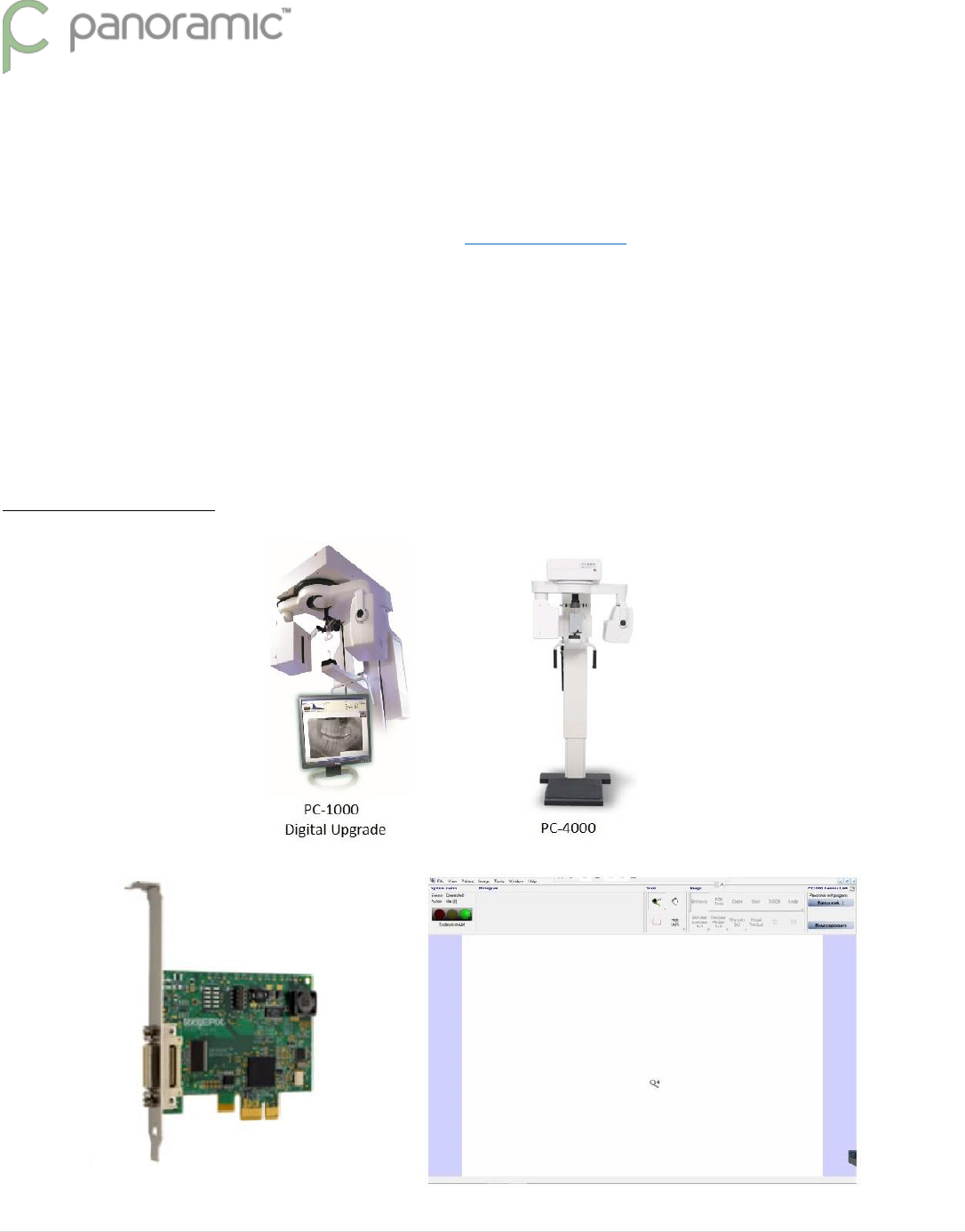
1 | P a g e
COMPUTER SETUP INSTRUCTIONS
Whether you are upgrading or replacing your current dedicated panoramic x-ray machine computer; please follow these steps to
ensure a successful transition to your new computer.
Panoramic Technical Support can be reached at 800-654-2027 / suppo[email protected]m for any questions.
PANORAMIC DENTAL IMAGING
Computer & Software Setup Instructions
for a computer with Windows 10 Professional 64-bit
Used with X-ray Machines:
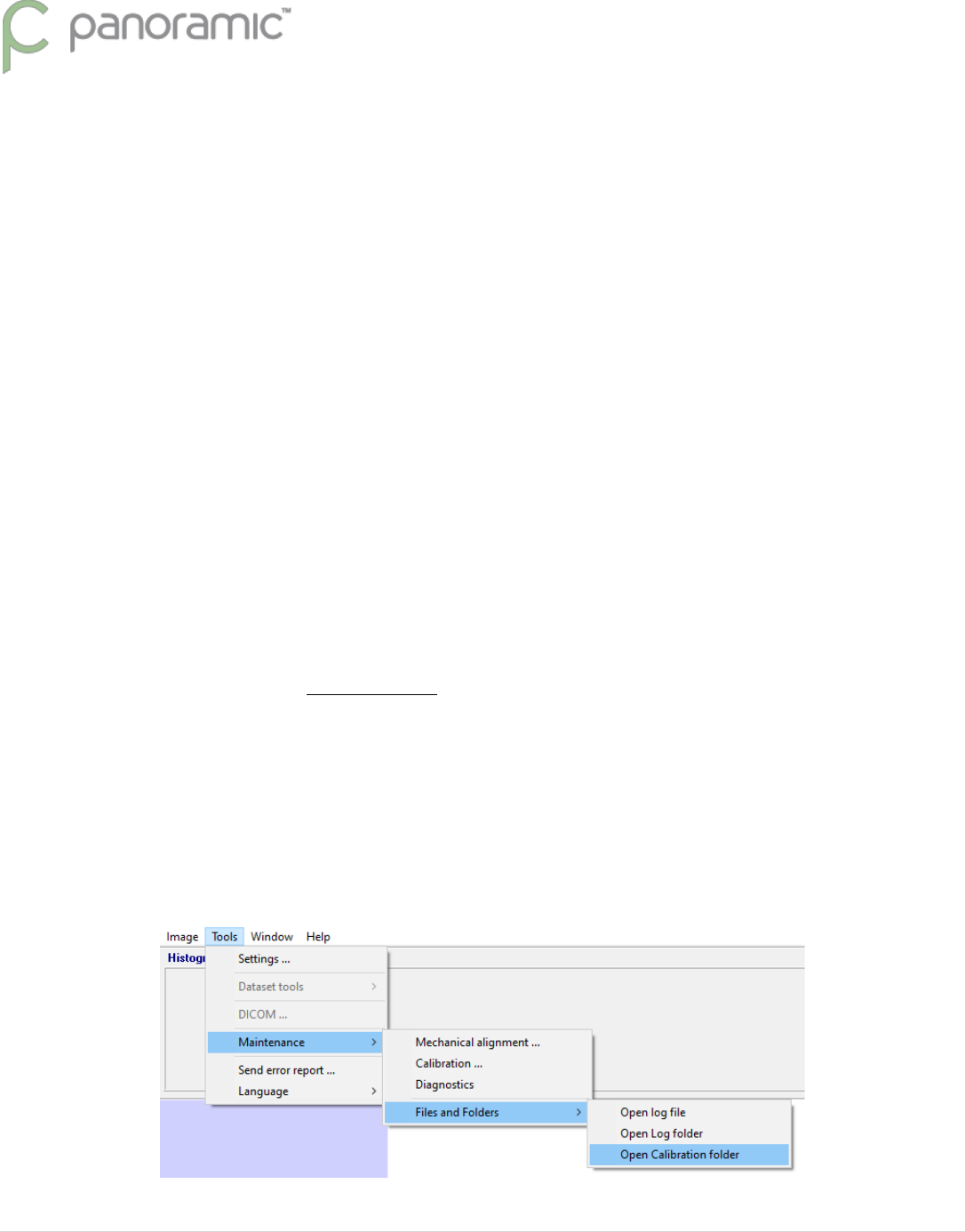
2 | P a g e
Pre-Setup – from the existing computer
Backup Calibration Files
Identify capture card
Computer Information
Setup – on the new computer
Verify Computer Operating System & Type
Disable Sleep, Hibernate, & Fast Startup
Install Software - Panoramic Dental Imaging
Install or Configure Drivers for capture card
Verify or Configure Software Settings– Panoramic Dental Imaging
Restore Calibration Files
Adjust Image Appearance
BACKUP CALIBRATION FILES
On the existing computer, backup the calib & datastor hidden folders:
Required -- C:\ProgramData\Ajat\panoramic\calib\
Optional -- C:\ProgramData\Ajat\panoramic\datastor\
Note: The datastor folder is used to reload recent images taken. It is not used as a long-term backup.
Alternatively these folder can be accessed from the software under the Tools Menu. If calibration files are not available
on the existing computer due to a computer issue/crash, then a new set of calibrations can be created by having an X-
ray Technician visit your office. Call Support for details.
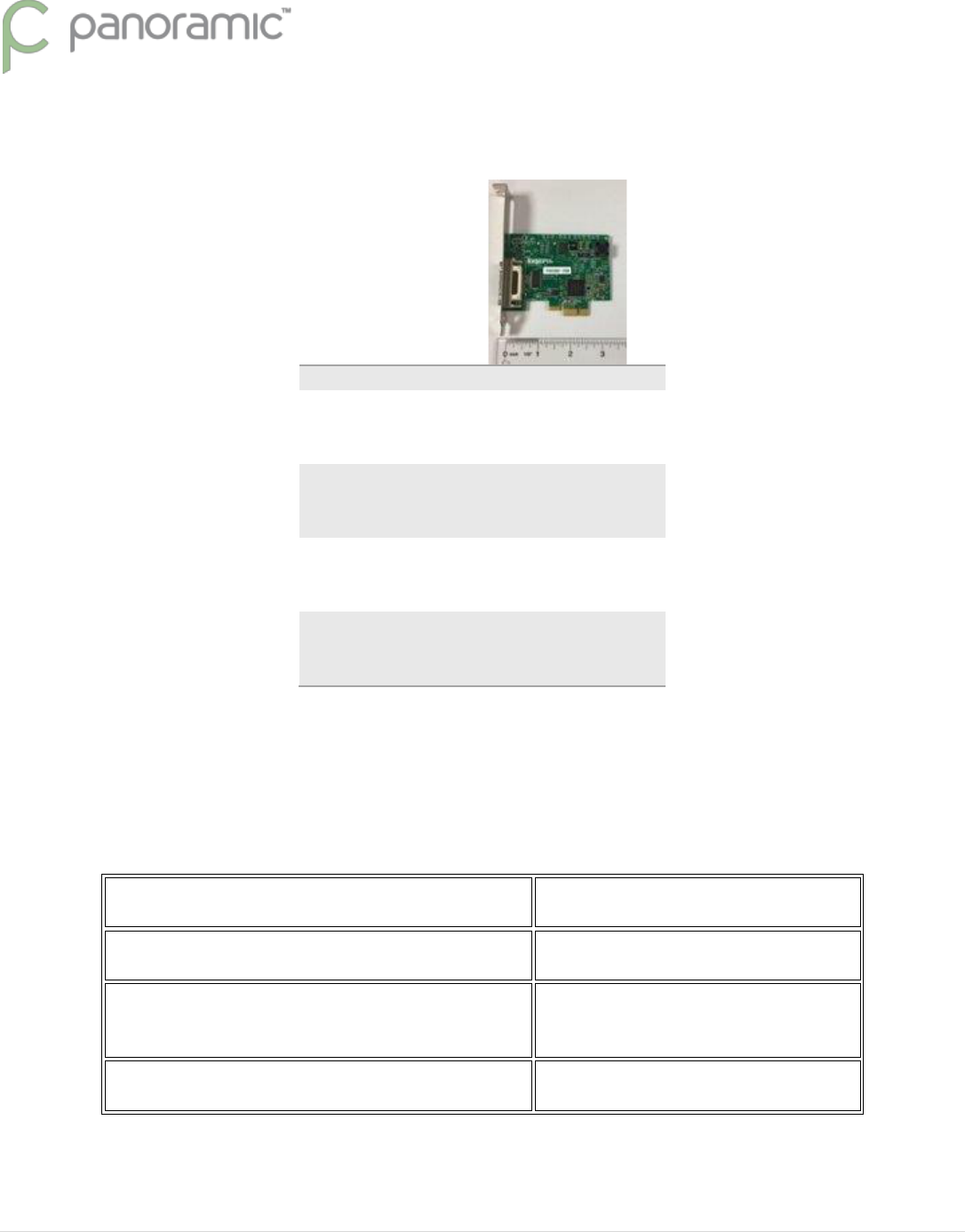
3 | P a g e
IDENTIFY CAPTURE CARD
Type
Epix EB1
Expansion
Slot
PCI Express x1 or x16
(use x16 slot for
Windows 10)
Size
Full or Half Height
- call to order different
size bracket
Compatible
Operating
Systems
Windows 7 or 10
32 and 64 bit
Used with
Pano
Machines
PC-1000 Digital
PC-4000
COMPUTER INFORMATION
The PC used must be a Windows desktop tower. Mac computers & Mac OS not supported. Laptops & All-in-One computers will not
work because the capture card must be installed in the next computer.
Processor (Intel Brand Required)
i5 6th Generation or later
RAM
8 GB
Hard Drive
500+ GB or greater,
7200 RPM or faster
One Available Expansion slot
PCI-Express x16
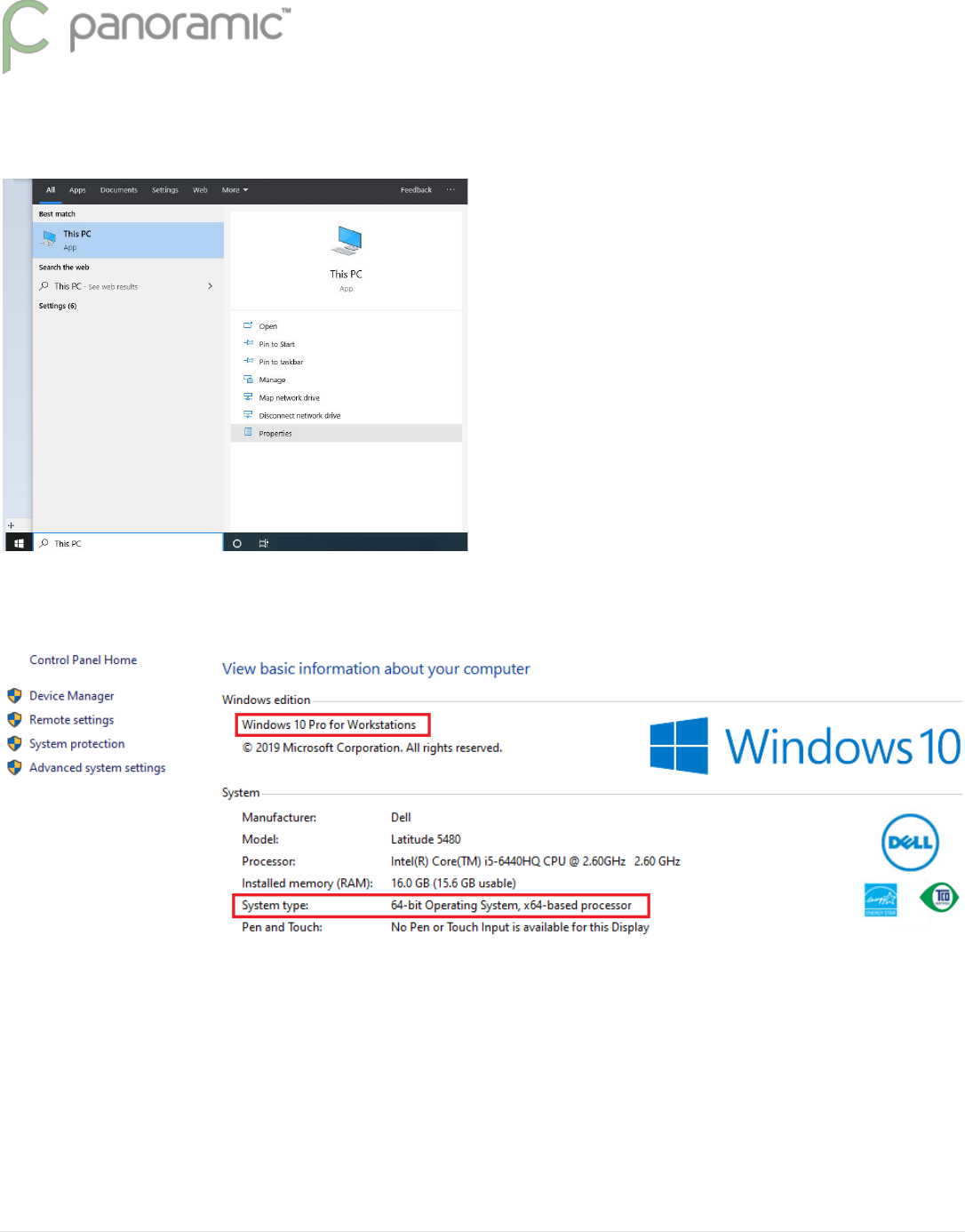
4 | P a g e
VERIFY COMPUTER OPERATING SYSTEM & TYPE
From the Start Menu, type “This PC” and click on Properties
An Example is shown. Windows 10 Professional, 64-bit Operating System
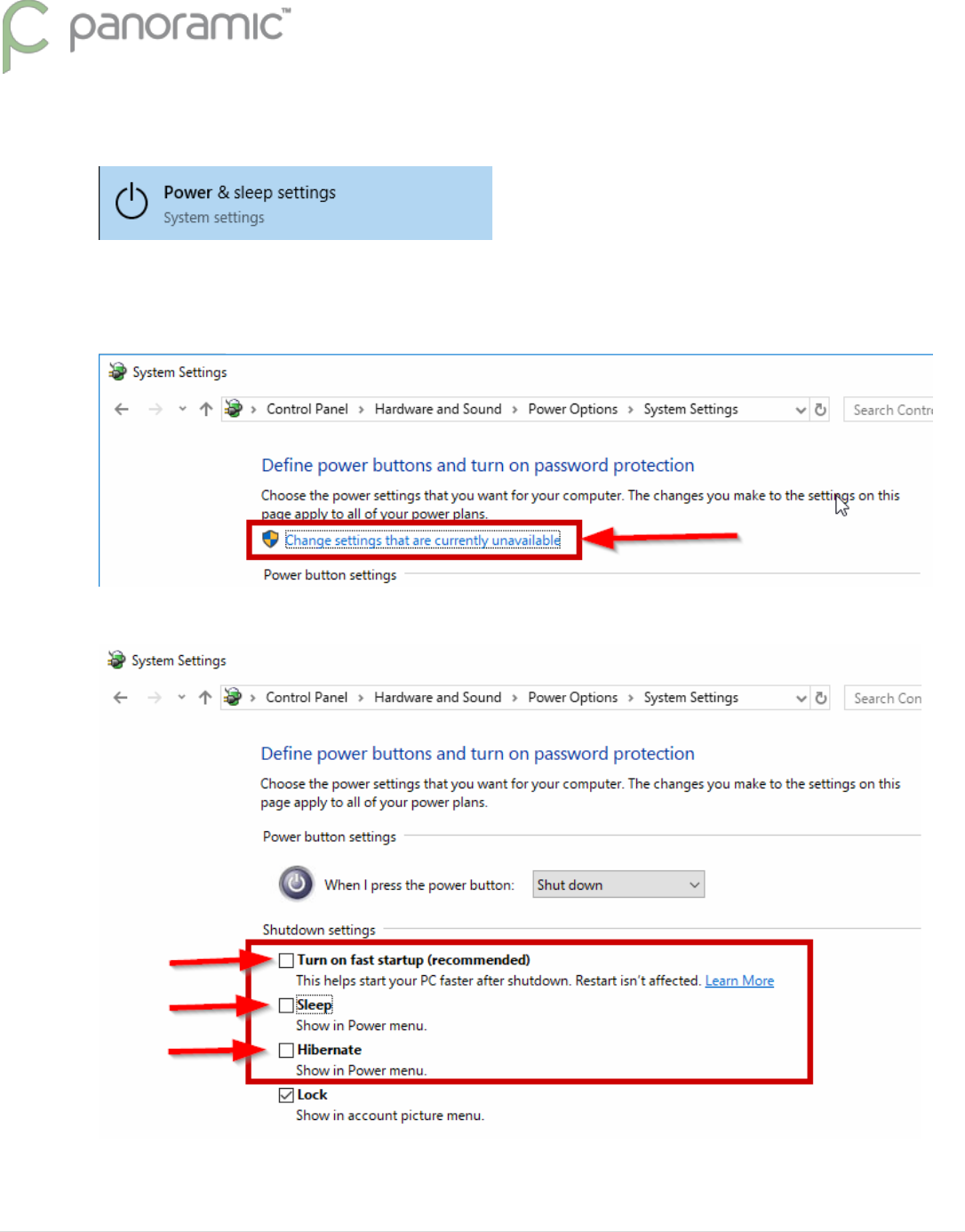
5 | P a g e
DISABLE SLEEP, HIBERNATE, & FAST STARTUP
a. If PC is windows 10, open the start menu and type “power” click on the “Power and sleep settings”.
b. On the right side of the window, under Related settings, click “Additional power settings”.
c. On the left side of the window, click “Choose what the power buttons do”.
d. Near the top of the window click “Change settings that are currently unavailable”.
e. Uncheck the boxes.

6 | P a g e
INSTALL SOFTWARE - PANORAMIC DENTAL IMAGING SOFTWARE
Note: If previously installed, or if this is an upgrade from Windows 7, make sure to uninstall any previous versions of the
program, listed as Panoramic Dental Imaging, or formerly called Ajat Dental Imaging.
Download and Run the software Installation. Panoramic Dental Imaging 9.1.2.7600.exe
Use the Default selections by clicking the Next buttons. Here are the screens to show the prompts.
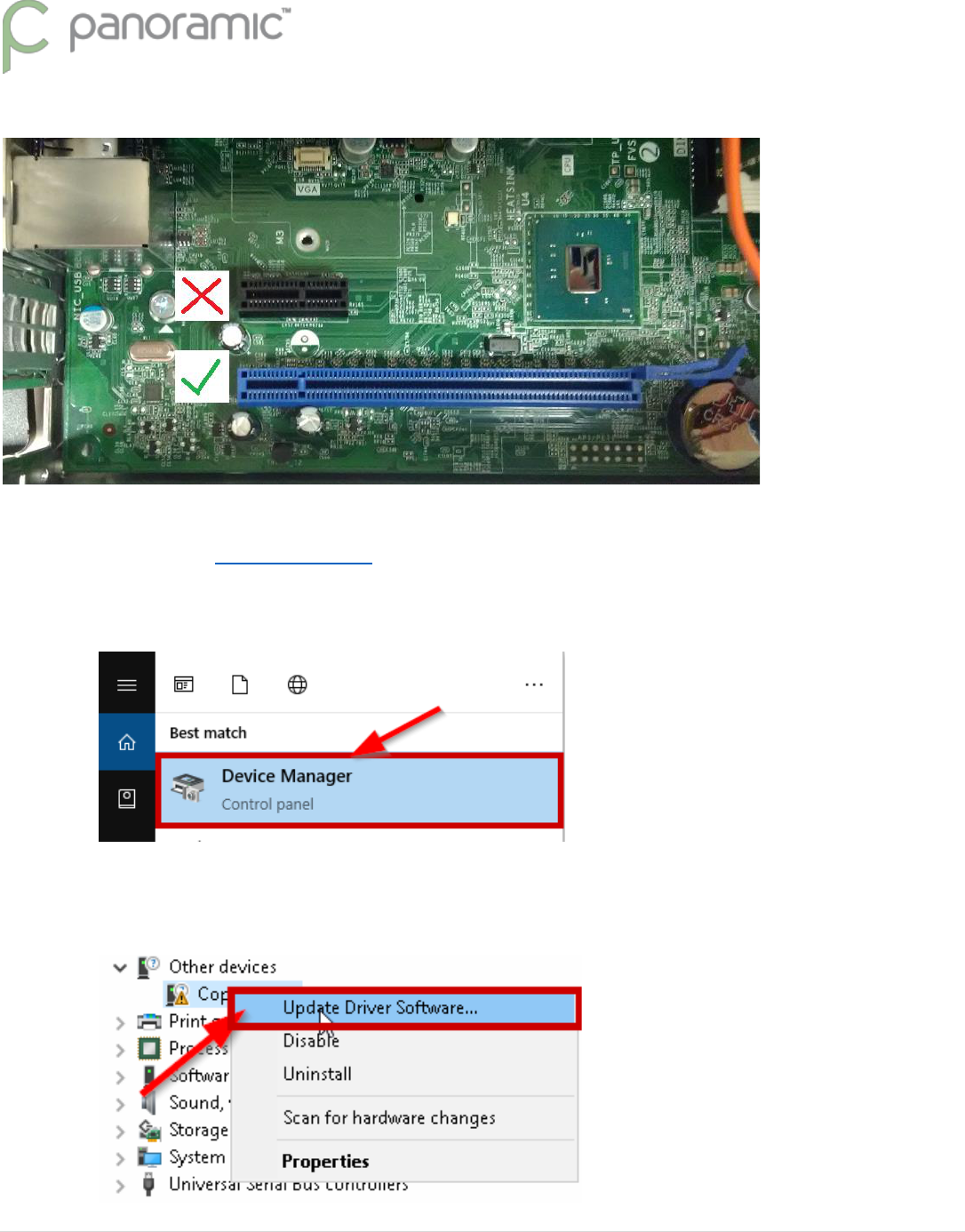
7 | P a g e
Make sure to use a x16 (4 inch) slot when using the EPIX EB1 card with Windows 10.
INSTALL EPIX DRIVERS – USE PCI-E X16 SLOT
a. Download the EPIX EB1 Drivers.zip and extract the appropriate drivers for your OS version to your desktop.
b. Open the start menu and search “device manager” and click on the “device manager” result.
c. In the “other devices” category, there may be a device named “Coprocessor” or “PCI device” Right-click on
the device and chose “update driver software”.
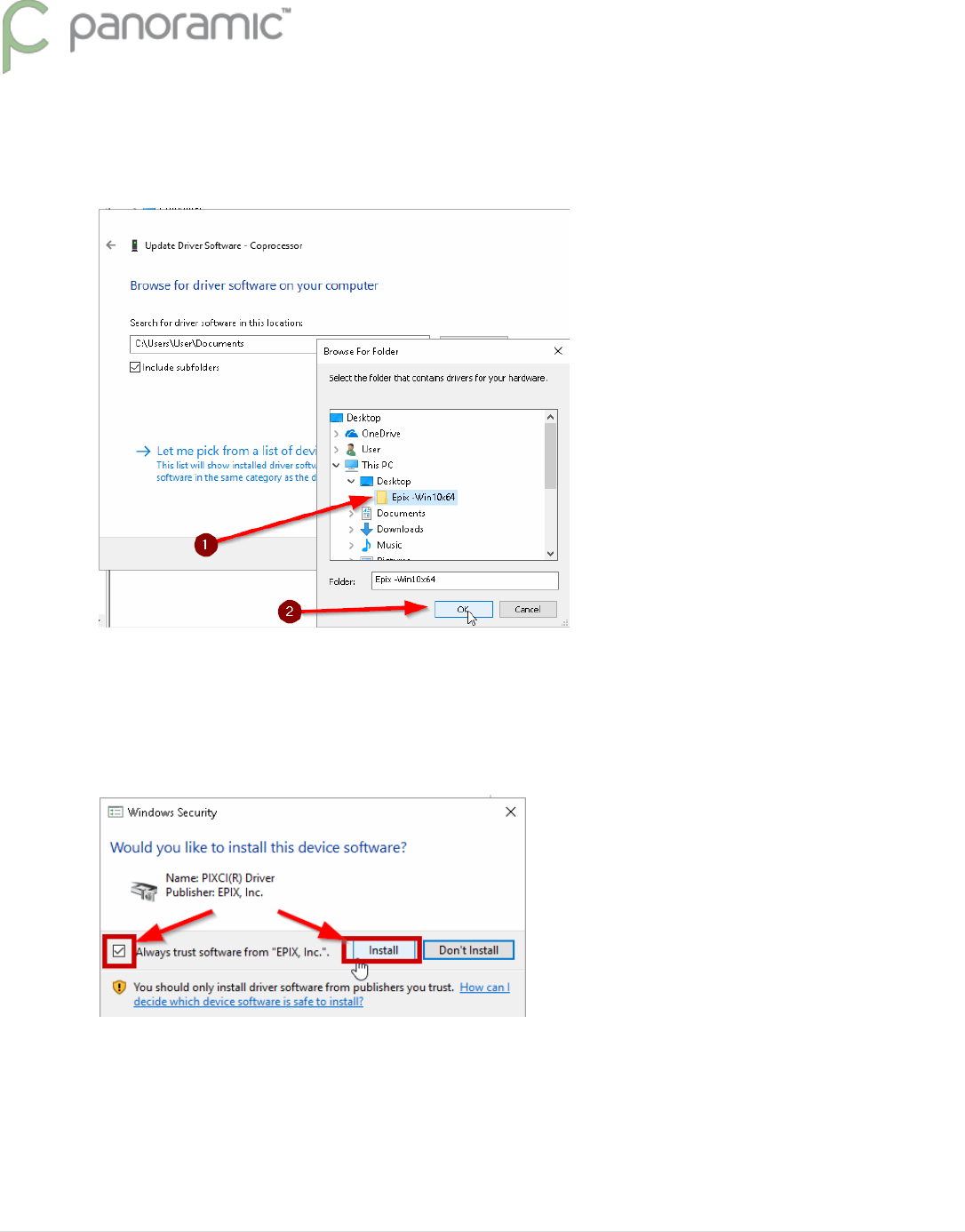
8 | P a g e
d. Click “browse my computer for driver software”.
e. At the top click the “browse” button and navigate to the folder on your desktop and click “ok”.
f. Click “next” on the update driver window.
g. If any security box pops up, make sure the “always trust software from “EPIX, inc” is checked and click
“install”.

9 | P a g e
h. After it successfully installs the driver click “close” on the update driver window.
i. If it says you need to reboot the computer to finish installing the device, click “no” for now.
j. The capture card should now be under the “imaging devices” category in the device manager.
k. From the drivers folder previously downloaded, double-click on the
“EPIXXCW6_memory_limit” file and click “yes” on the window that pops
up to merge, and “OK”.
RESTART THE COMPUTER
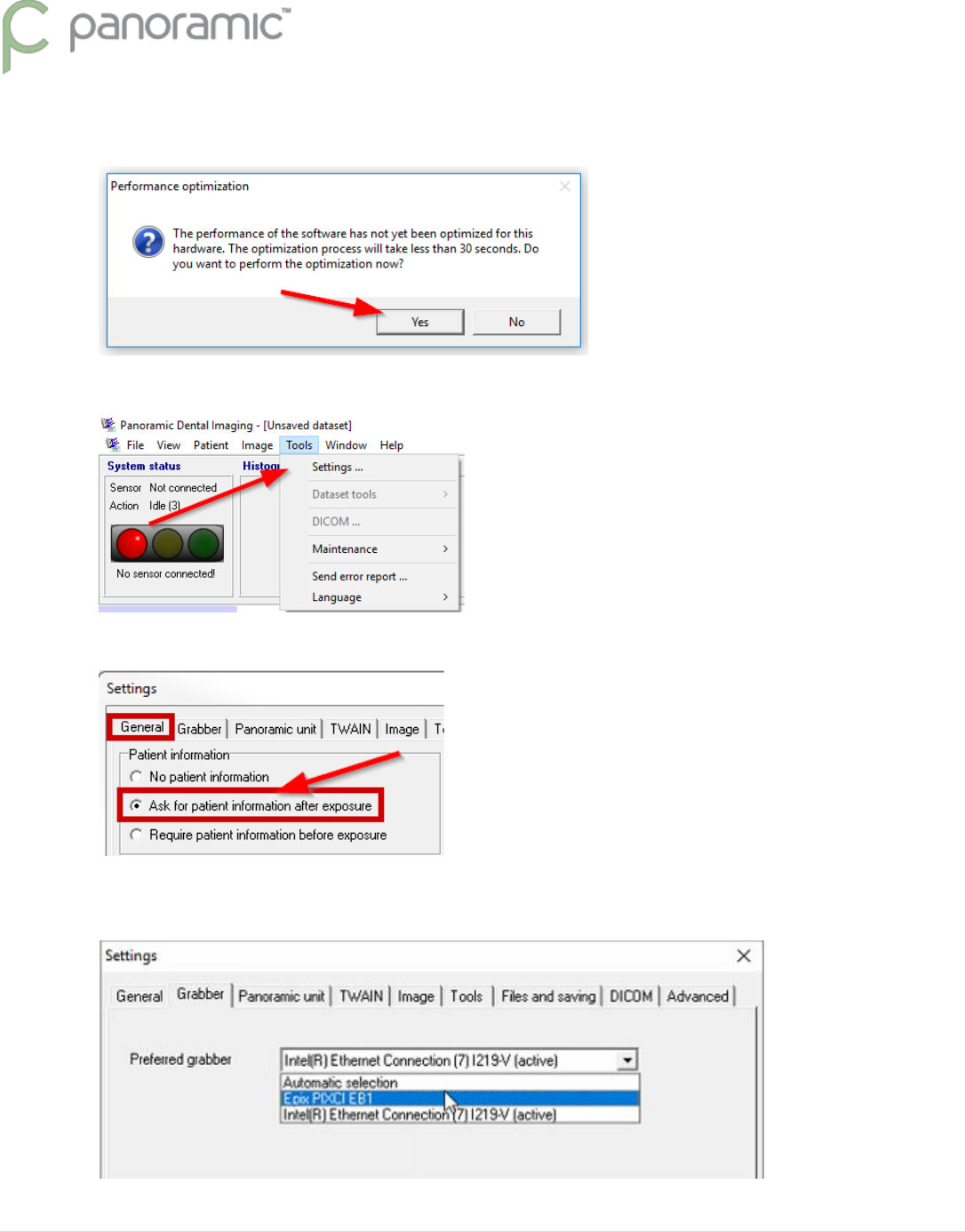
10 | P a g e
VERIFY OR CONFIGURE THE PANORAMIC DENTAL IMAGING SOFTWARE
a. Open the “Panoramic Dental Imaging” software If prompted about Performance optimization click Yes.
b. At the top of the software click “Tools” then “Settings…”
c. Click on the “General” tab and select “Ask for patient information after exposure”.
d. Click on the “Grabber” tab and Ensure the proper preferred grabber is selected (EPIX EB1).
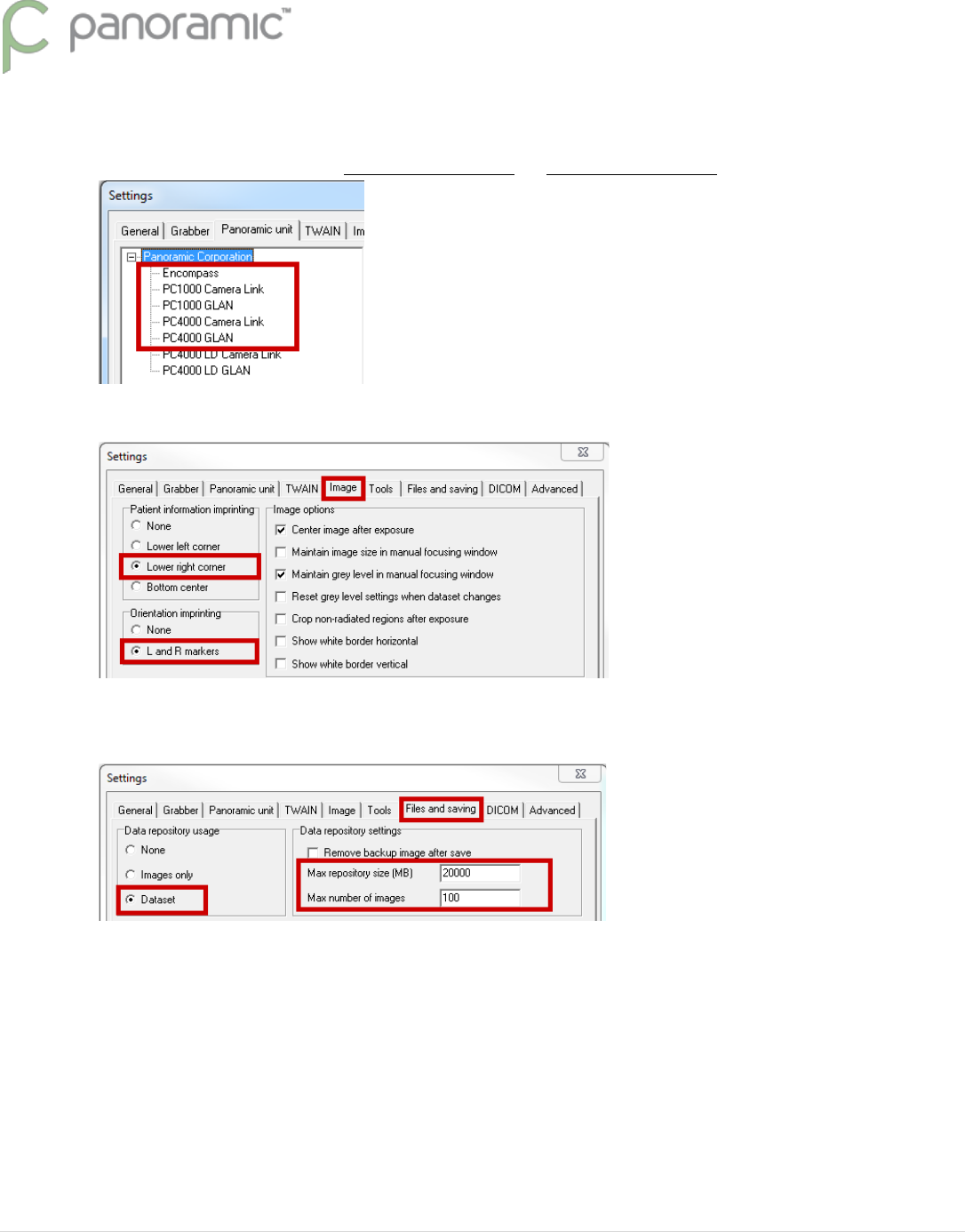
11 | P a g e
e. Click the “Panoramic unit” tab and chose your type of x-ray machine from the list. If you have the Intel NIC
card, chose the GLAN version of the machine.
PC1000 CAMERALINK OR PC4000 CAMERALINK
f. Click the “Image tab” and check the options of “Lower right corner” and “L and R markers”.
g. Click the “Files and saving” tab, and select “dataset”, set the “Max repository size” to “20000”, and the “Max
number of images” to “100” (these numbers can be adjusted to fit computer needs).
h. Click “ok” on the settings windows to save your settings, if prompted to Reboot your PC, click “yes”.
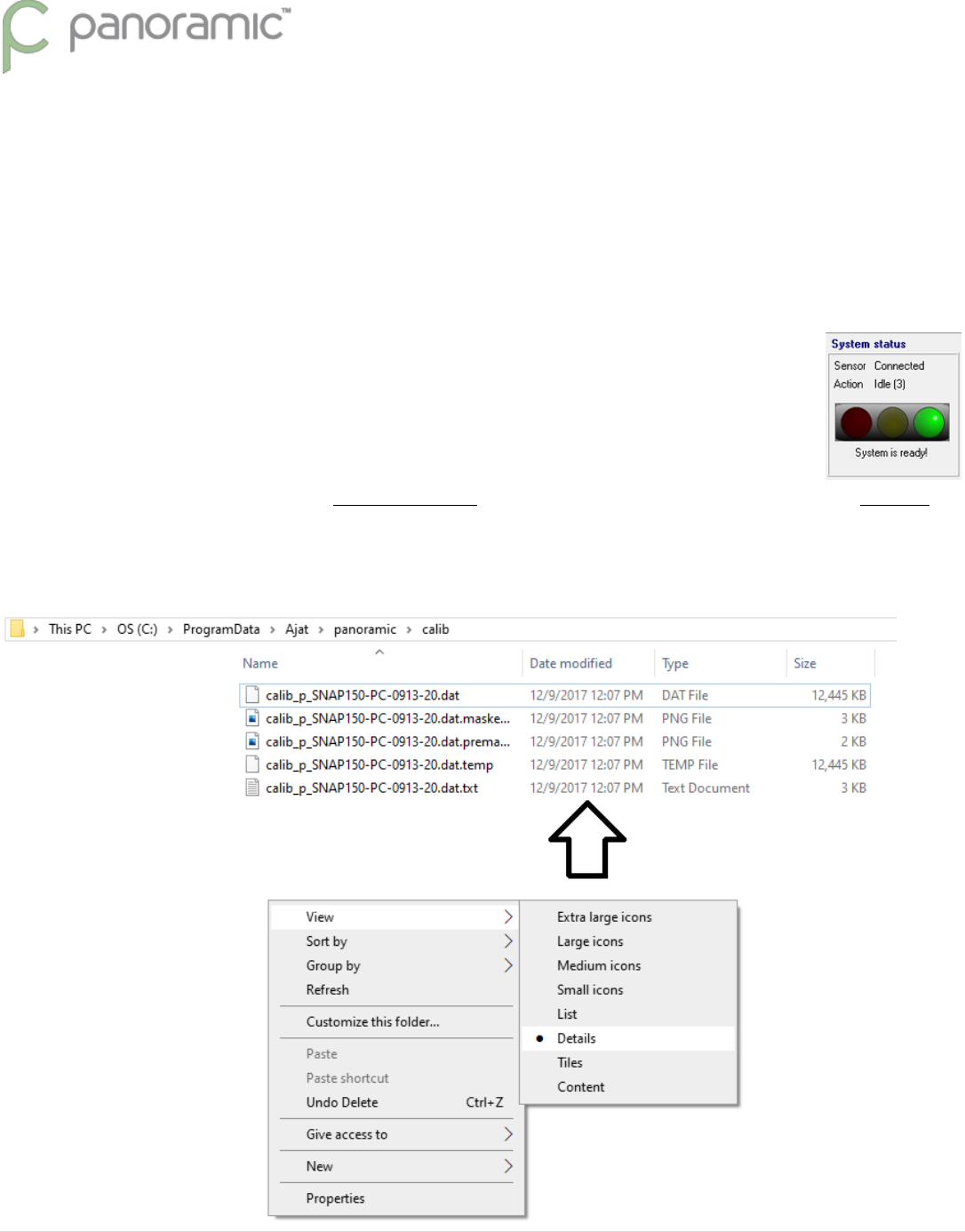
12 | P a g e
RESTORE THE CALIBRATION FILES
a. The calibration files should have been backed up from the previous computer. Copy all files in that folder to
the same location on the new PC.
C:\ProgramData\Ajat\panoramic\calib\
C:\ProgramData\Ajat\panoramic\datastor\
Note: This folder is created automatically after the software has been setup/configured. Make sure to
not copy the folder into itself. Example: C:\ProgramData\Ajat\panoramic\calib\calib\ (wrong)
b. Power the X-ray machine Off, or ensure the sensor is powered off, wait 5 seconds, and power back On.
c. Verify GREEN CONNECTION status light in the TOP LEFT corner of the software program
Call Panoramic Support if problematic. 800-654-2027 opt. 1 for the Service Dept.
Important Note: If the calibration date is older than 2 years, please contact Technical Support or your Local Certified
Technician for recalibration. Panoramic Corporation strongly recommends Recalibration of the X-Ray unit & Software
every 2 years. If you cannot see the Date modified column, then you need to change the view of the folder to Details.
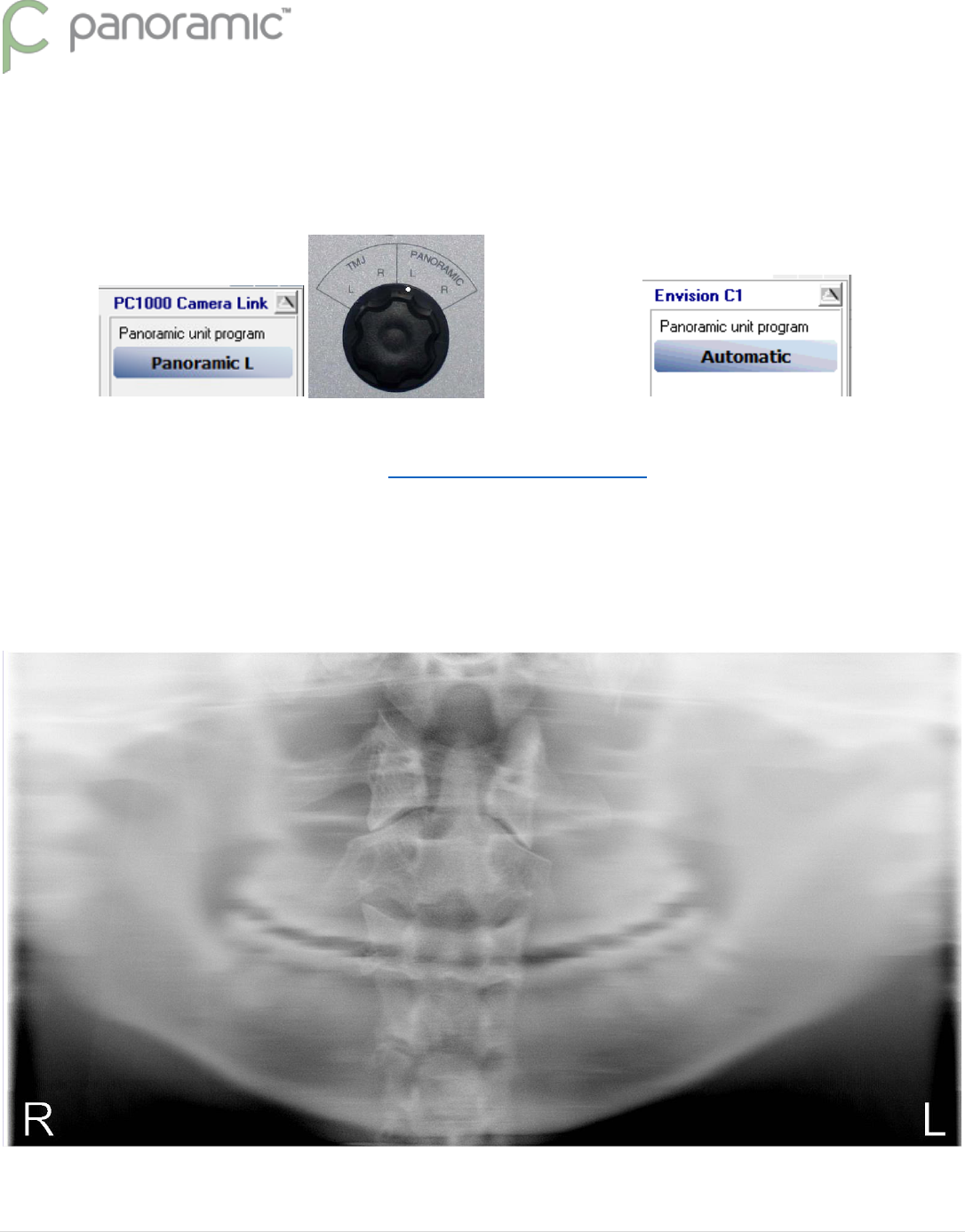
13 | P a g e
ADJUST IMAGE APPEARANCE
a. Ensure the Software direction L/R (top right of screen) matches the Machine direction L/R (side panel)
A green connection to the software/sensor is required to change this button direction
a. Because this is a new computer the images by default will be very light until adjusted. You can follow the
instructions listed on page 20 of the Guide to getting the best images to adjust the default image
adjustments
How to Correct VERY blurry images from using the wrong direction captured
Only for PC1000 & PC4000 units.
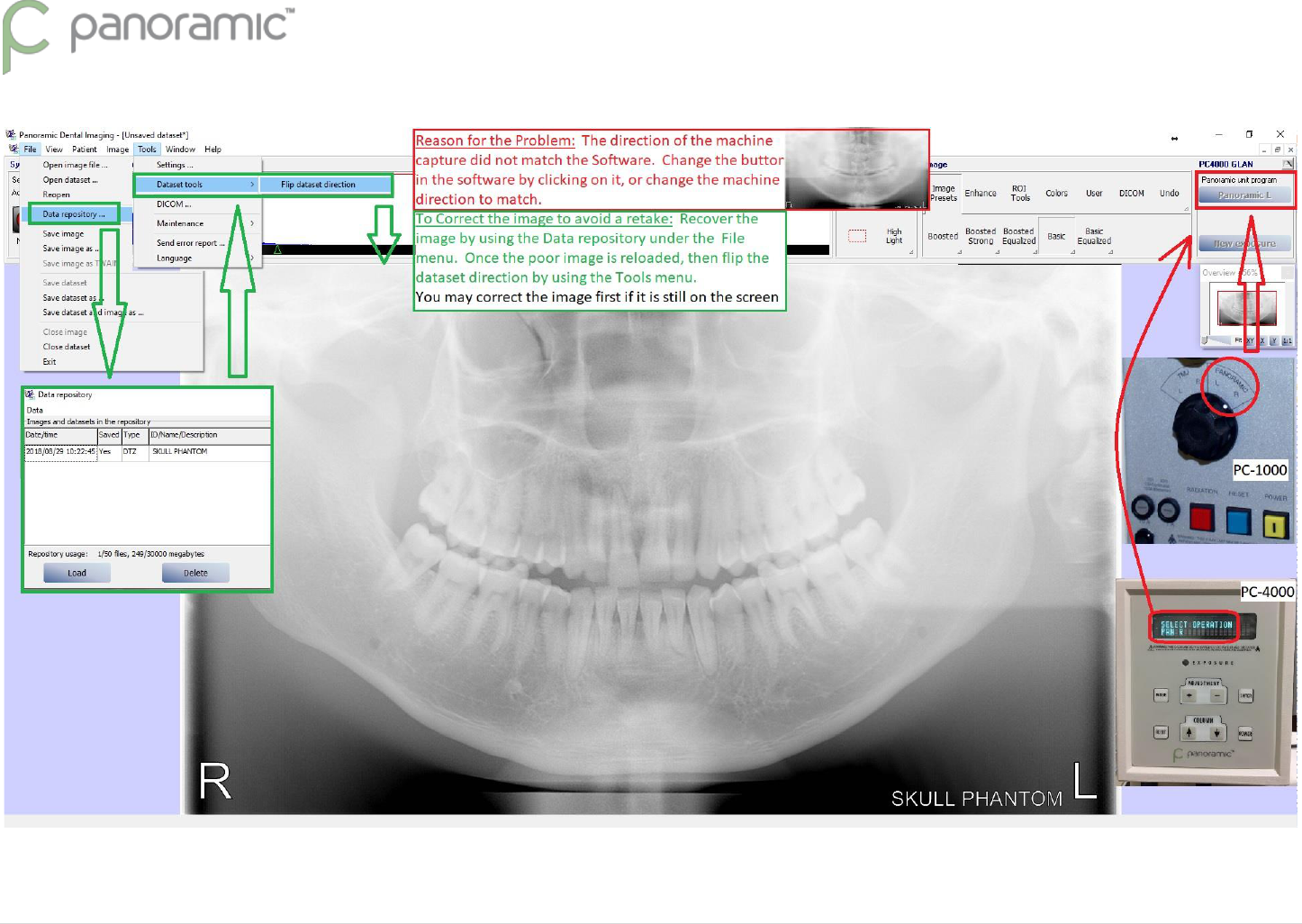
14 | P a g e
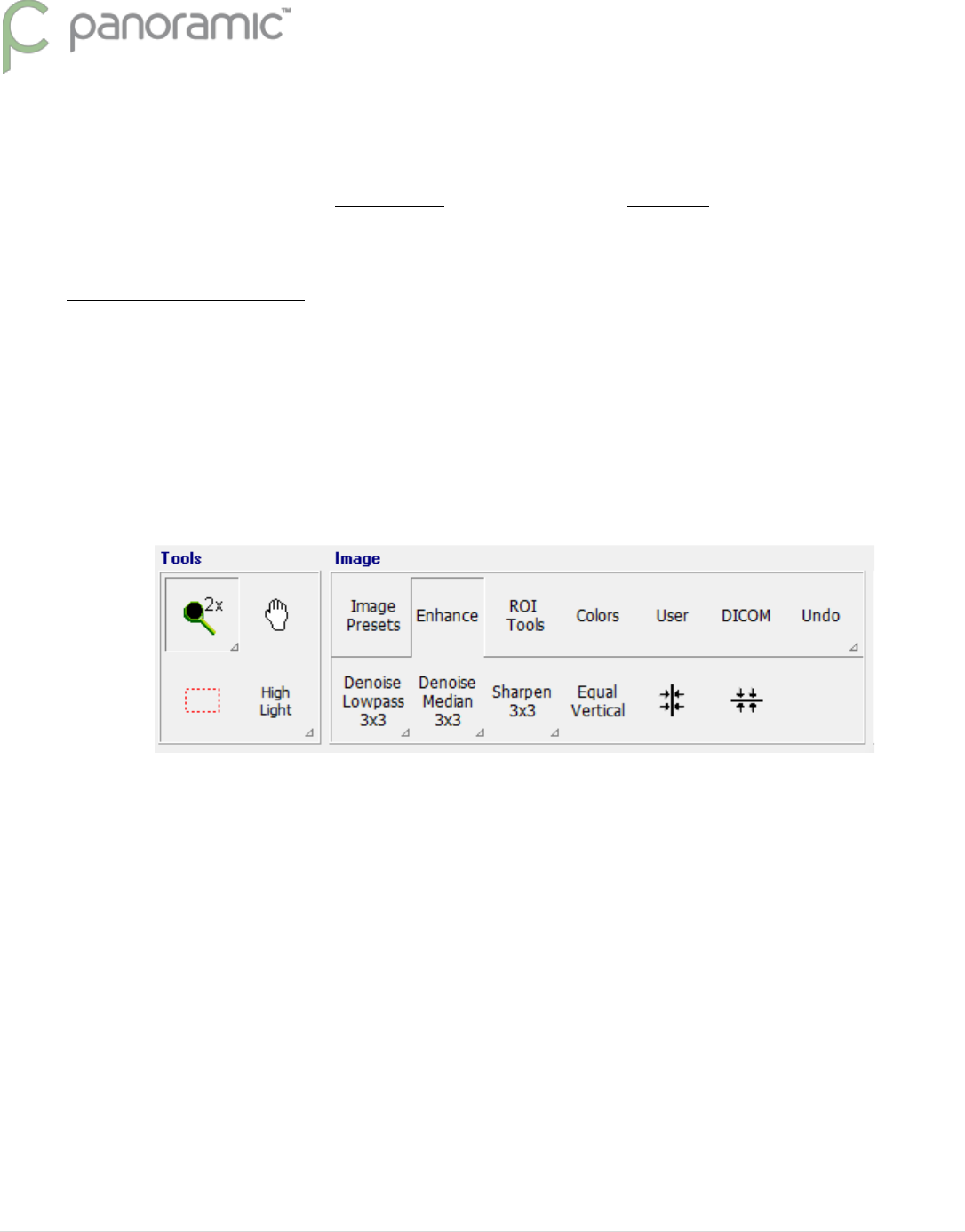
15 | P a g e
Helpful hints on making your panoramic images better!
After taking a panoramic x-ray there are two main tools that we prefer everybody use before the image
is saved. Those two tools are the Equal Vertical tool and adjusting the Histogram graph.
Equal Vertical tool
Description: The Equal Vertical tools will equalize the columns in the image. This should be the first tool
used after taking a panoramic x-ray. For example, the center of the image is generally lighter because of the
spinal shadow due to the position of the patient. To help minimize this “shadow” of the spine in the image,
using the tool will darken the middle and lighten the sides, balancing the difference in darkness across the
image.
The Equal Vertical tool is located under the Enhance button to view the buttons beneath.
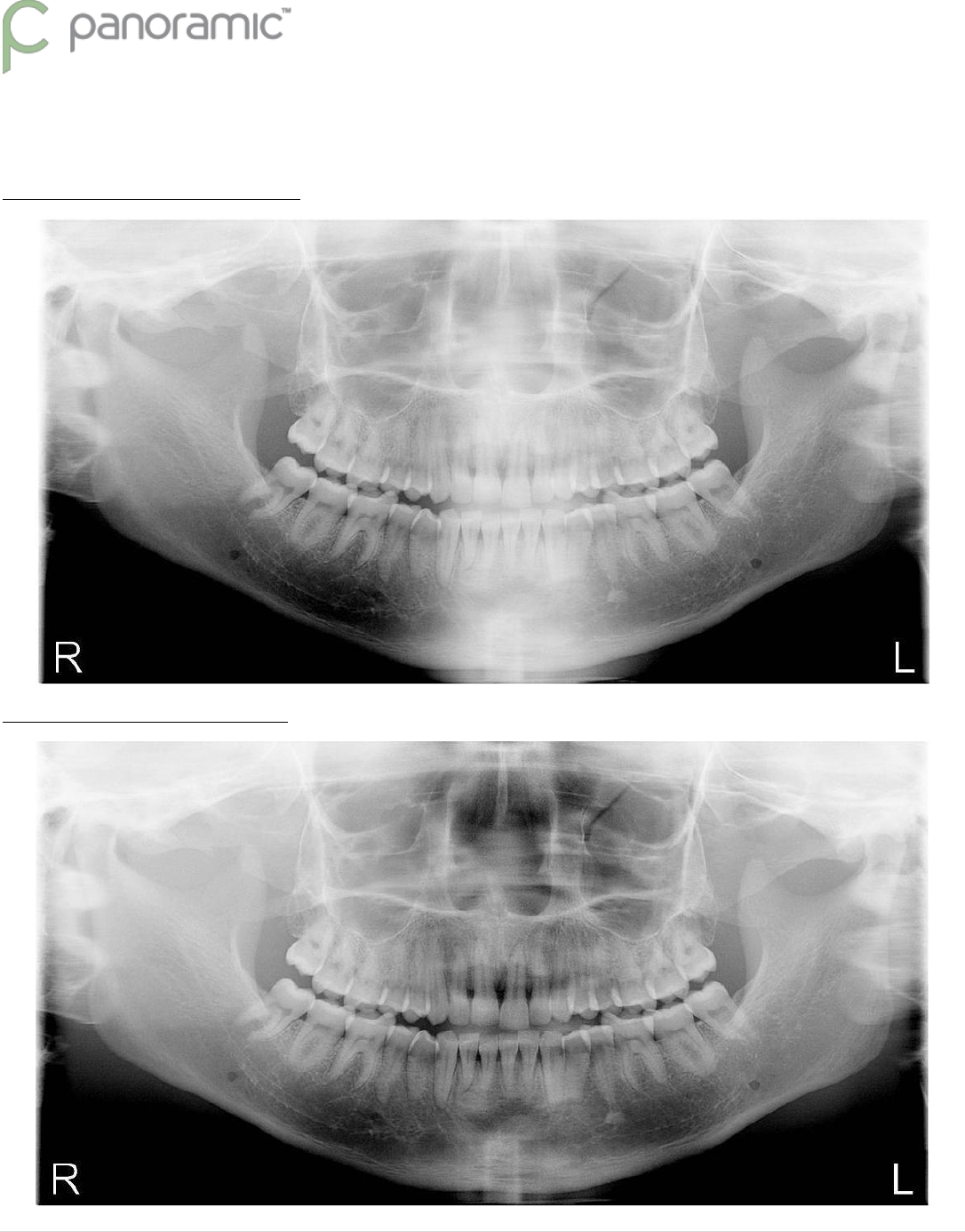
16 | P a g e
Below is an example when using the Equal Vertical tool.
Before the Equal Vertical tool is used:
After the Equal Vertical tool is used:
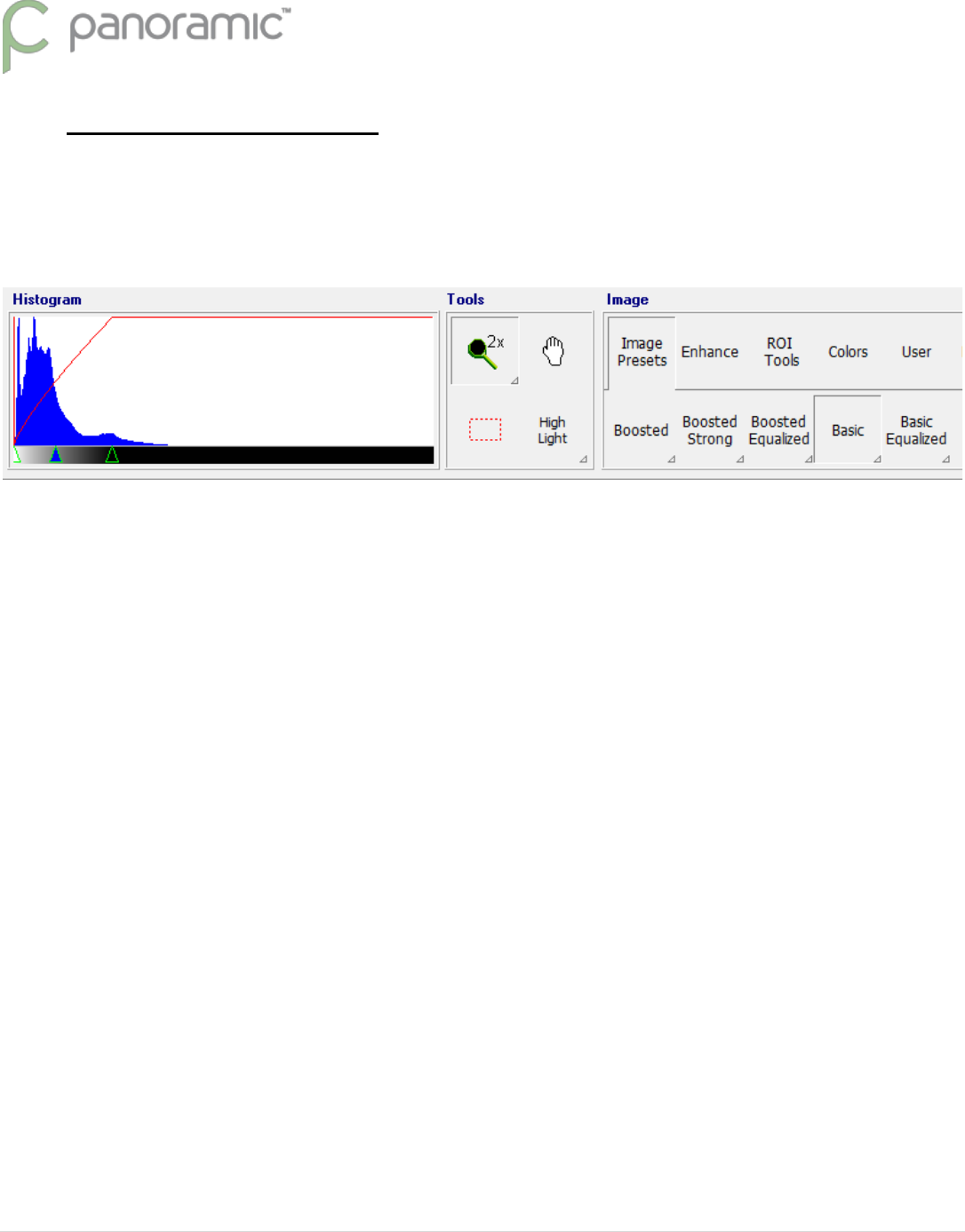
17 | P a g e
Adjusting the histogram
After the Equal Vertical tool is used, it is best to adjust the brightness and contrast to get the best detail
out of the x-ray. This is the second tool that should be used after taking a panoramic x-ray. This tool is called
the Histogram.
As seen in the examples above, there are three small green triangles at the bottom of the tool. Moving
these triangles side-to-side will adjust the brightness and contrast values of the image. To move the triangles
simply left-click the triangle using the mouse and drag them side to side. When the triangle is in its desired
position, release the left-mouse button. Be careful not to overlap the triangles when adjusting them, otherwise
the software will not know which triangle to move. To best learn this tool, adjust the triangles and notice the
difference in the image after the adjustment. Utilizing this tool can greatly improve the quality of the x-rays.
The farthest right triangle, usually seen as green outline with black in the center, controls the contrast or
darkness (dark levels) of the image. The default position for this triangle is against the far right side. This should
be the first triangle to be moved.
The middle triangle, usually seen as the green outline with blue center, controls the brightness of the
image. The default position for this triangle is right in the center. This is the second triangle to be moved.
The farthest left triangle, usually seen as green outline with white center, controls the whiteness (white
levels) of the image. The default position for this triangle is against the far left side. This triangle should
normally be ignored and kept in its default position.
Since every individual has a different opinion about getting the best detail with an x-ray, there is no set
of rules of how the x-ray should look. Therefore the best way to decide this ask the doctor (or talk amongst the
group) and decide what key parts in the x-ray are needed to be in focus and given attention to. The person that
will usually take the x-ray needs to be aware of what is needed, otherwise most (if not every) x-ray will not be to
the doctor’s liking. This is why communication is key when viewing/saving x-rays.
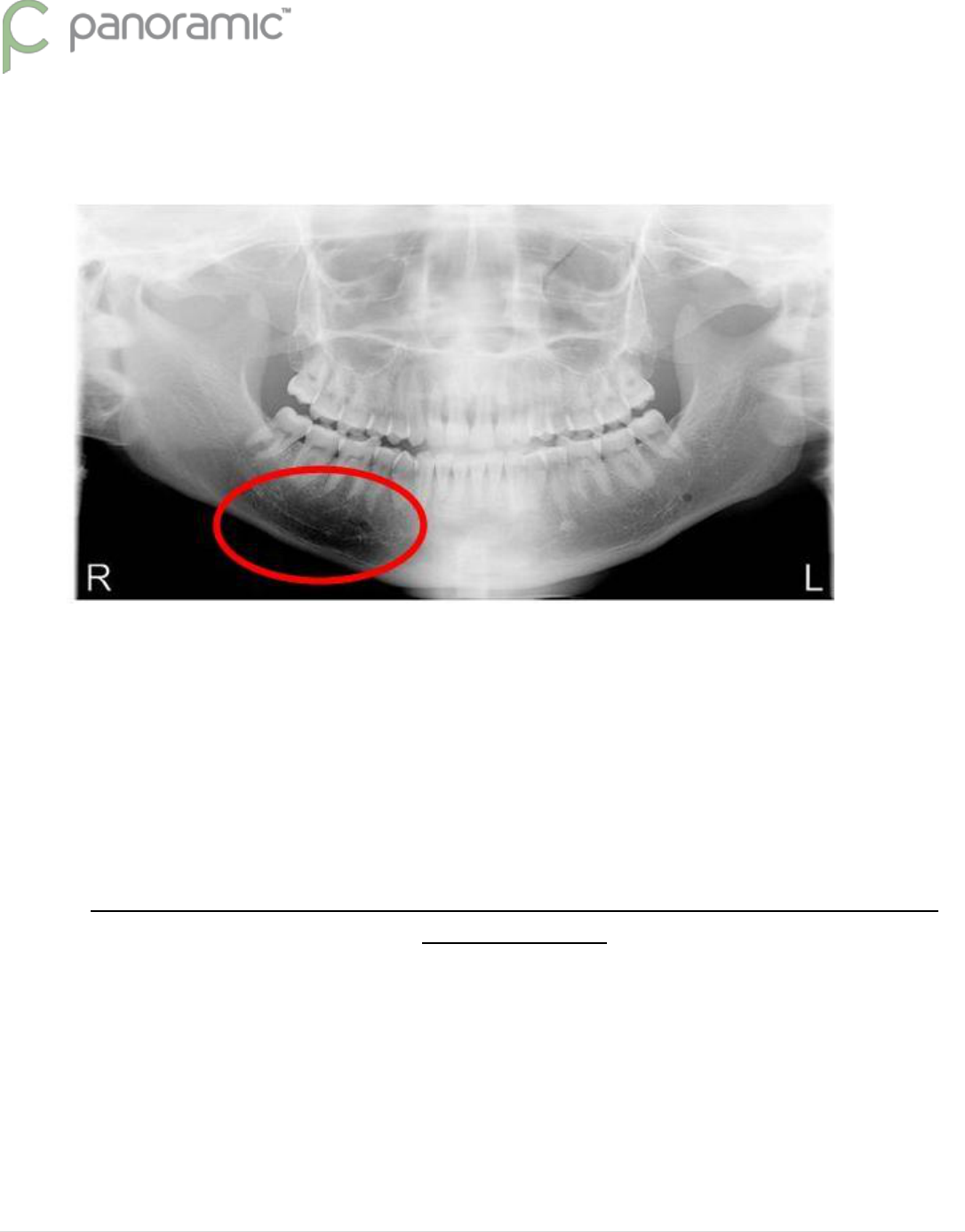
18 | P a g e
As an example on how to use this Histogram tool, adjust the contrast (most right) triangle from right to
left until you start to see “burn out” in the jawbone or skeletal figure. (See below)
Then adjust the brightness (middle) triangle side-to-side until you get the detail and clarity in the roots
of the teeth. Getting the detail desired may require you to re-adjust the contrast and brightness triangles more
than once. Do not be afraid to take some time if you feel you can get a better image. If you are unsure ask the
doctor or another staff member if the detail you have is acceptable or not. There is no wrong adjustment; it all
falls on personal preference.
Note: Patient positioning and correct kvp usage directly reflects the potential detail
seen in the image.
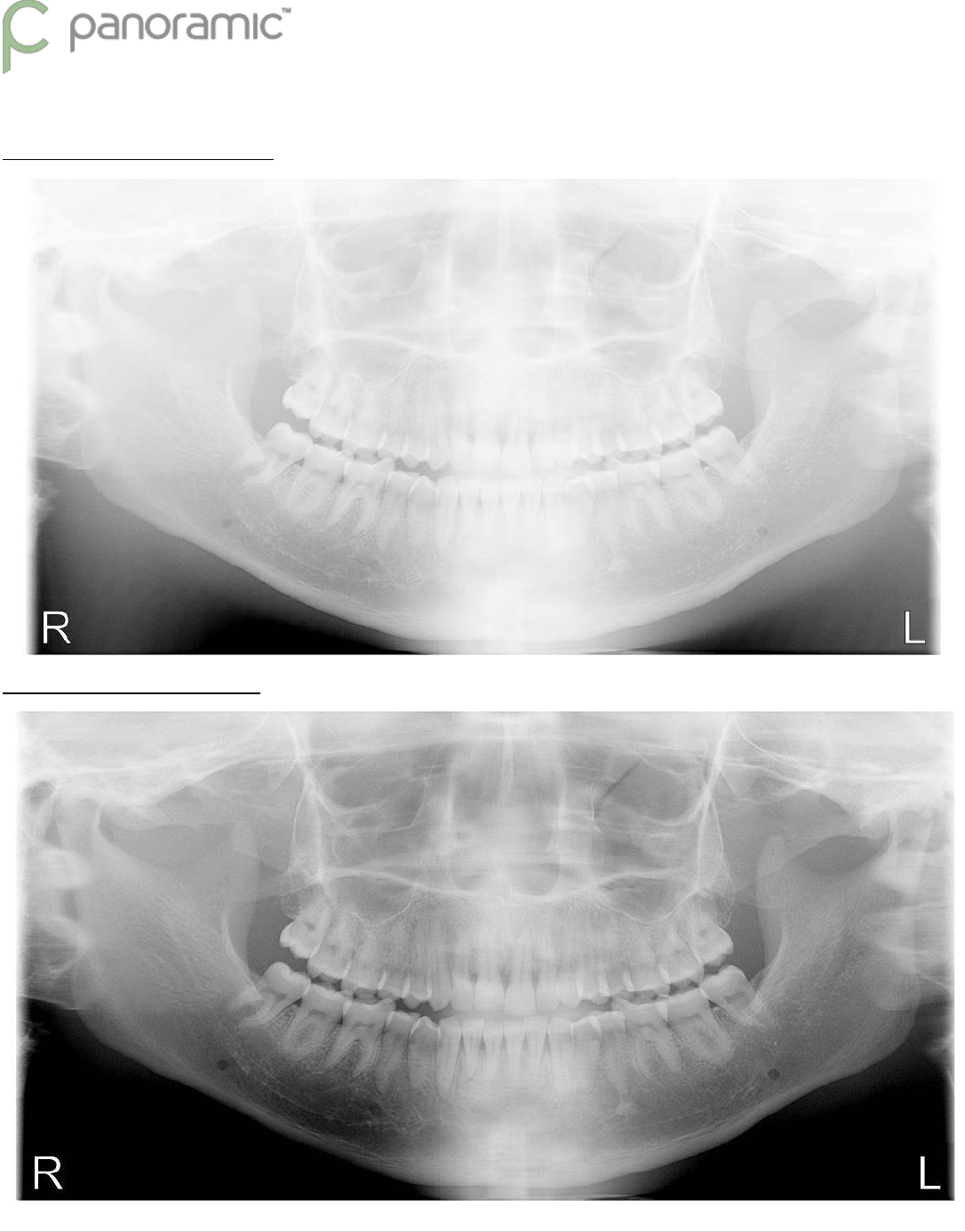
19 | P a g e
Below is an example when using the Histogram (or Image controls) tool.
Before the Histogram tool is used:
After the Histogram tool is used:
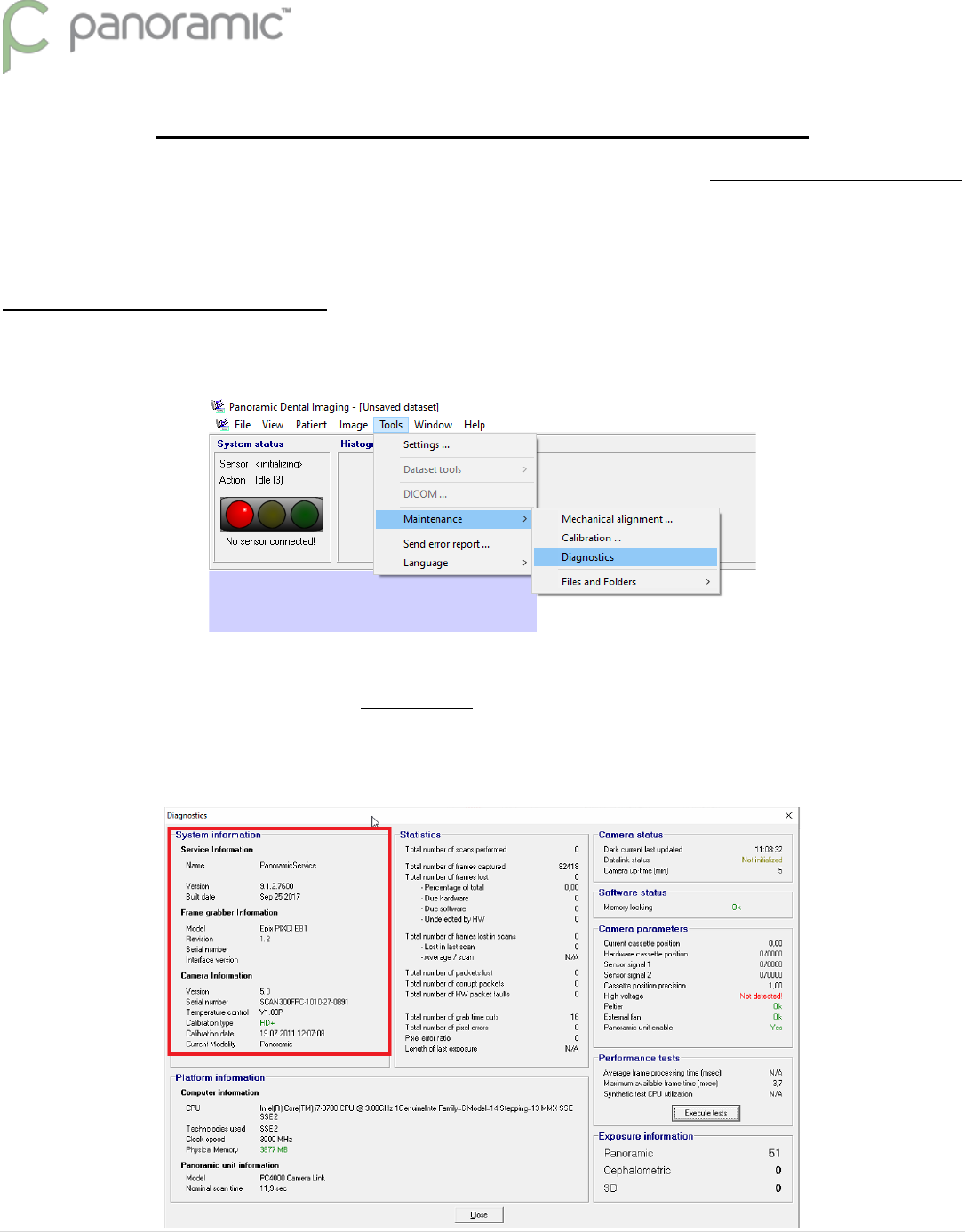
20 | P a g e
Troubleshooting Not Connected Status (EPIX)
Estimated Time: 2-20+ minutes
Note: Some instructions reference the steps used above in the installation steps.
These steps will be easier for an IT person to follow having computer experience.
Check Software Diagnostics
Check the software diagnostics for Frame Grabber Information. Under the Tools menu from the top, choose
Maintenance, and then Diagnostics.
The diagnostics screen shows (below in red) the software version 9.1.2.7600
The Frame grabber Information is where the Epix PIXCI EB1 should be listed.
This tells us the software is connected to the interface card. If any other is listed, then go to Grabber settings (Page 25)
To best rule out any software ‘hang-ups’ or ‘freezes’, restart the background service process.
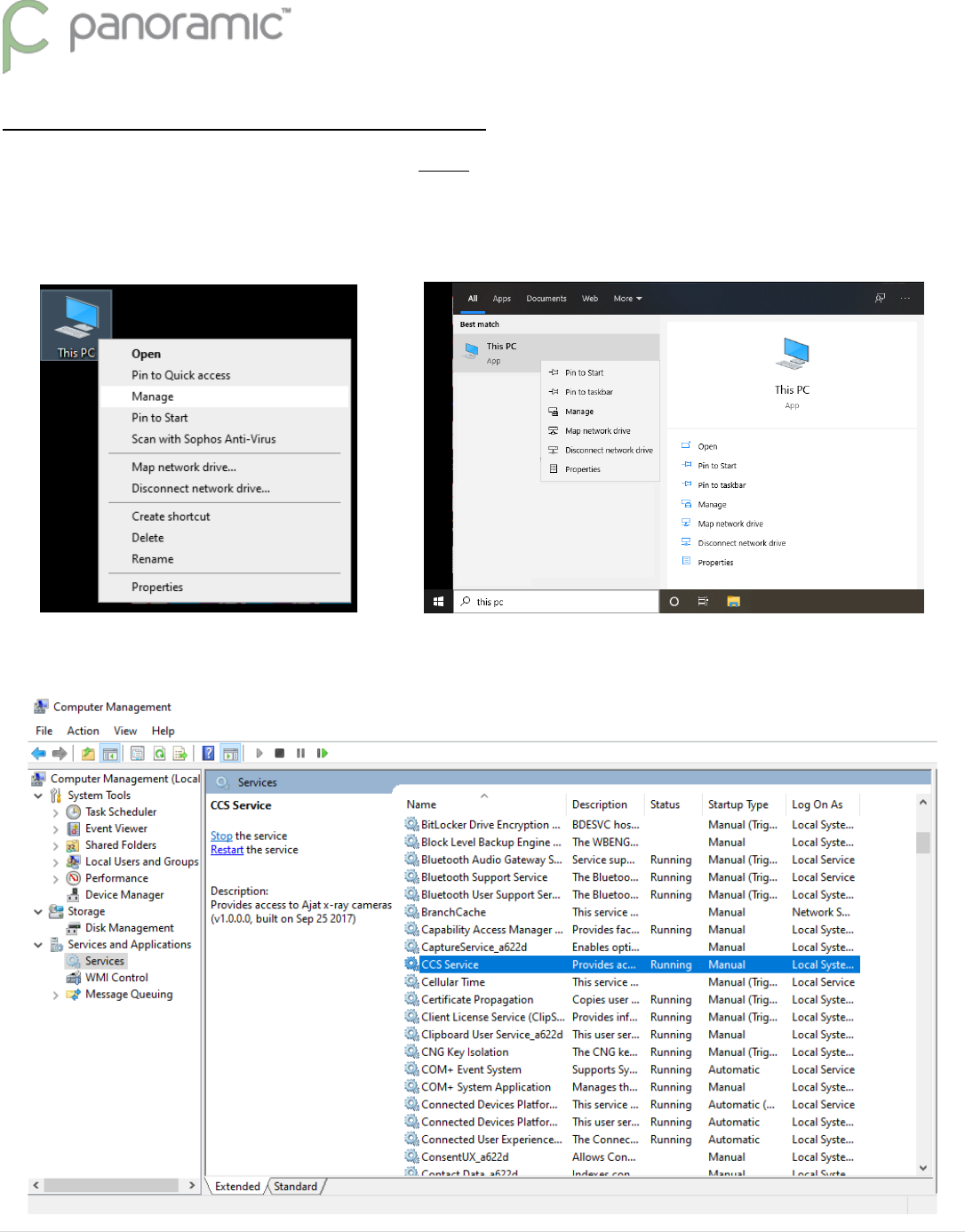
21 | P a g e
RESTARTING THE BACKGROUND SERVICE
(Important) To restart the background service, first CLOSE the PANORAMIC DENTAL IMAGING Software
Open up the Services list by right-clicking ‘This PC’ on the desktop and choosing Manage. If this icon is not on the
desktop, you can enable this in the control panel/settings > Display/Themes. Or type This PC from the start menu, and
right-click on the best match in the list, and click on Manage
Under the Services and Applications category, expand and then click on Services (left). The list of system processes are
listed on the right. Find ‘CCS Service’ in the list, highlight, and then click on the ‘Restart’ link to the top left.
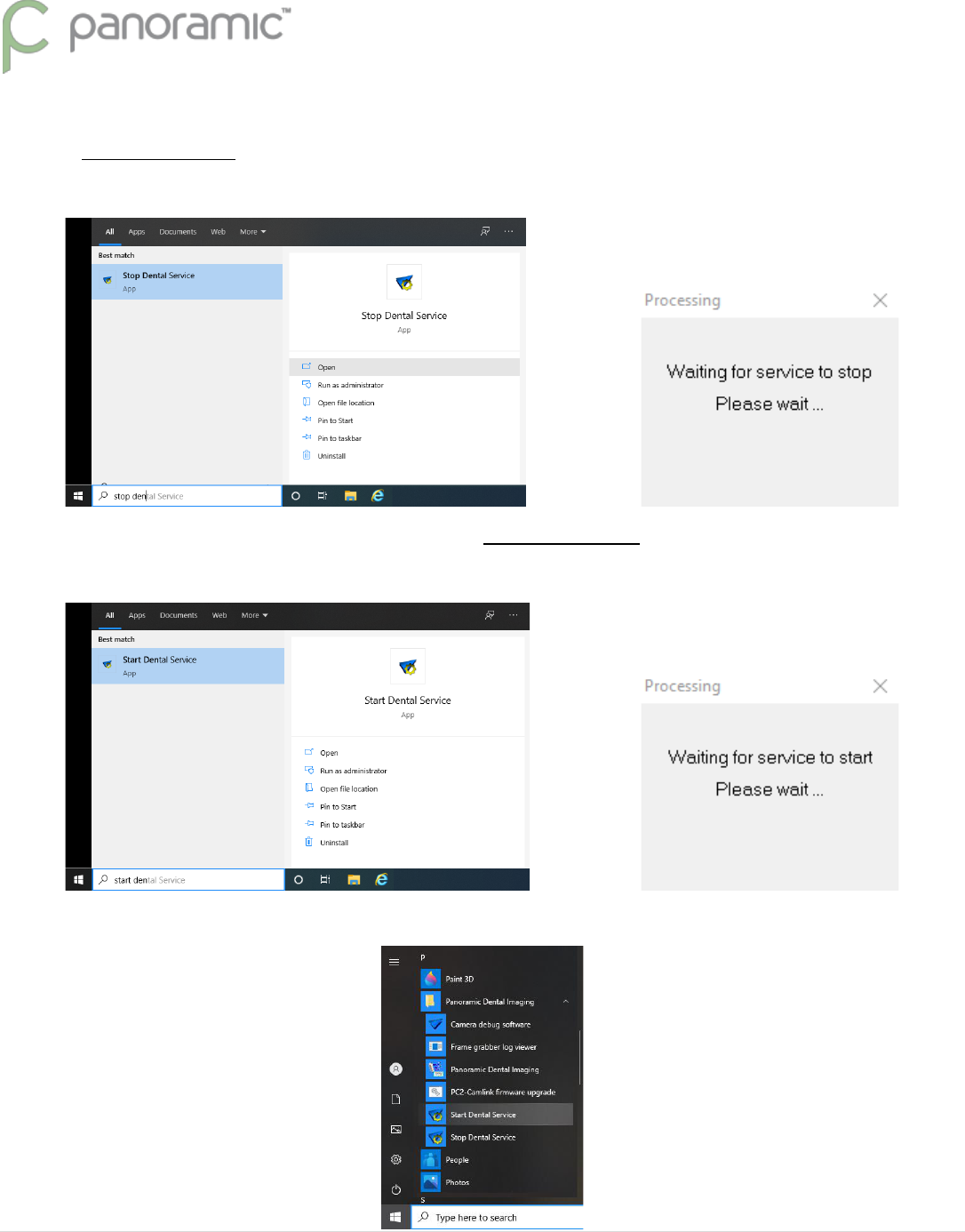
22 | P a g e
The background service can also be restarted by using the start menu search for “Stop Dental” and “Start Dental”
Open the Stop Dental Service program/command first.
Afterwards you’ll see a small box show a message “waiting for service to stop”
After the small box has disappeared, you can then Open the Start Dental Service program/command.
Again you will see a small box show a message “waiting for service to start”
These commands are also listed under the Start Menu > Panoramic Dental Imaging >
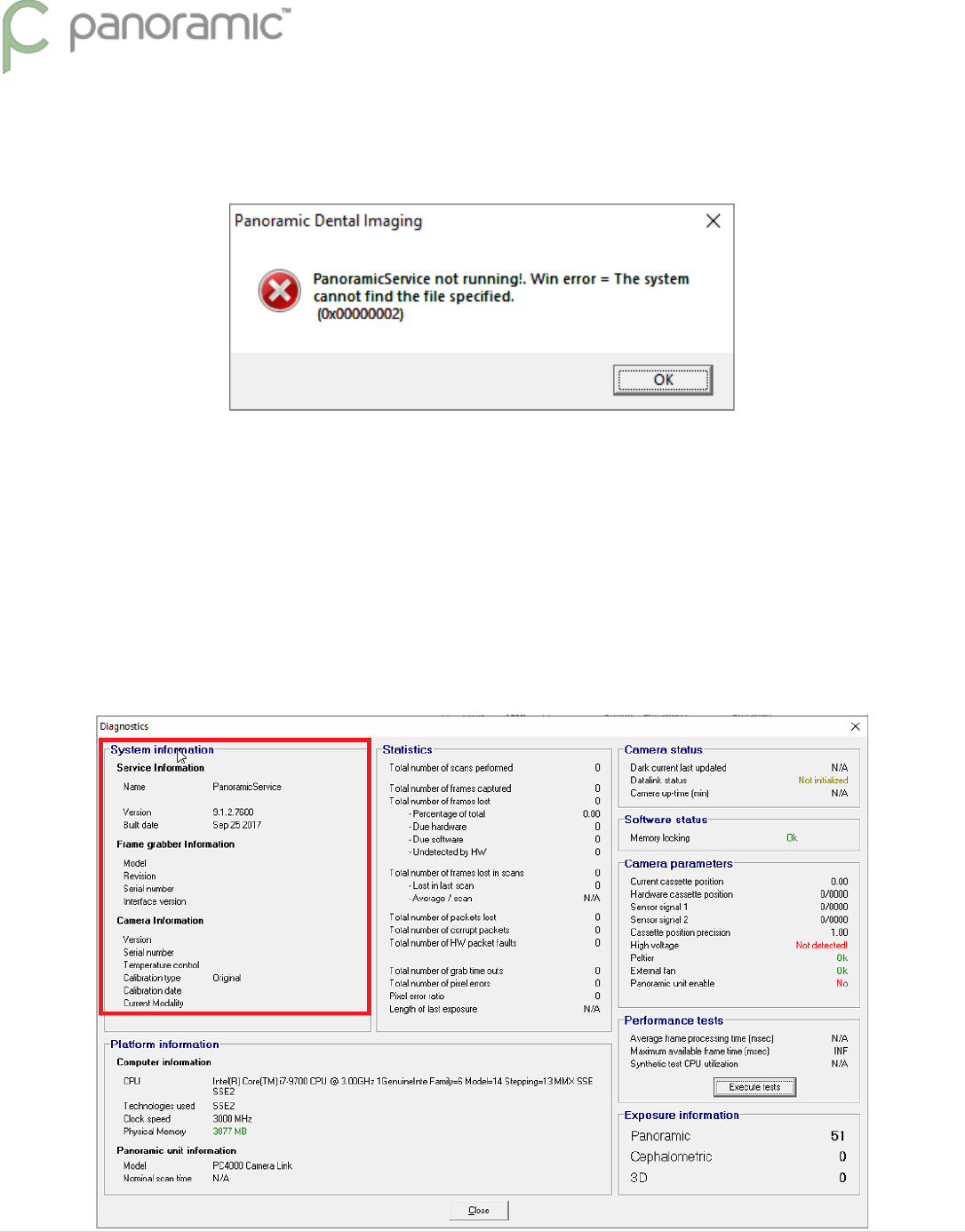
23 | P a g e
Note: If the Panoramic Dental Software is opened when the background service is NOT running, an error message will
appear as below. To correct this, start the background service as described above, and then the program can be opened.
SOLVED? Read the possible reasoning below; otherwise continue to the next steps…
If restarting the background service fixes the connection issue, it would suggest that software is not running the latest
version (and should be updated to v9.1.2.7600), or more likely that the software was hung up on a function and caused
the software to halt. If the problem continues, investigate adding the panoramic program to any exclusions list of any
Real-time scanning software (see below page 26, THIRD PARTY INTERFERENCE)
If still no connection, check the diagnostics screen again. If the “EPIX” description disappears after the restart of the
background service, this tell us the software can no longer communicate with the interface card. Verify if the EPIX card
is listed in the device manager.
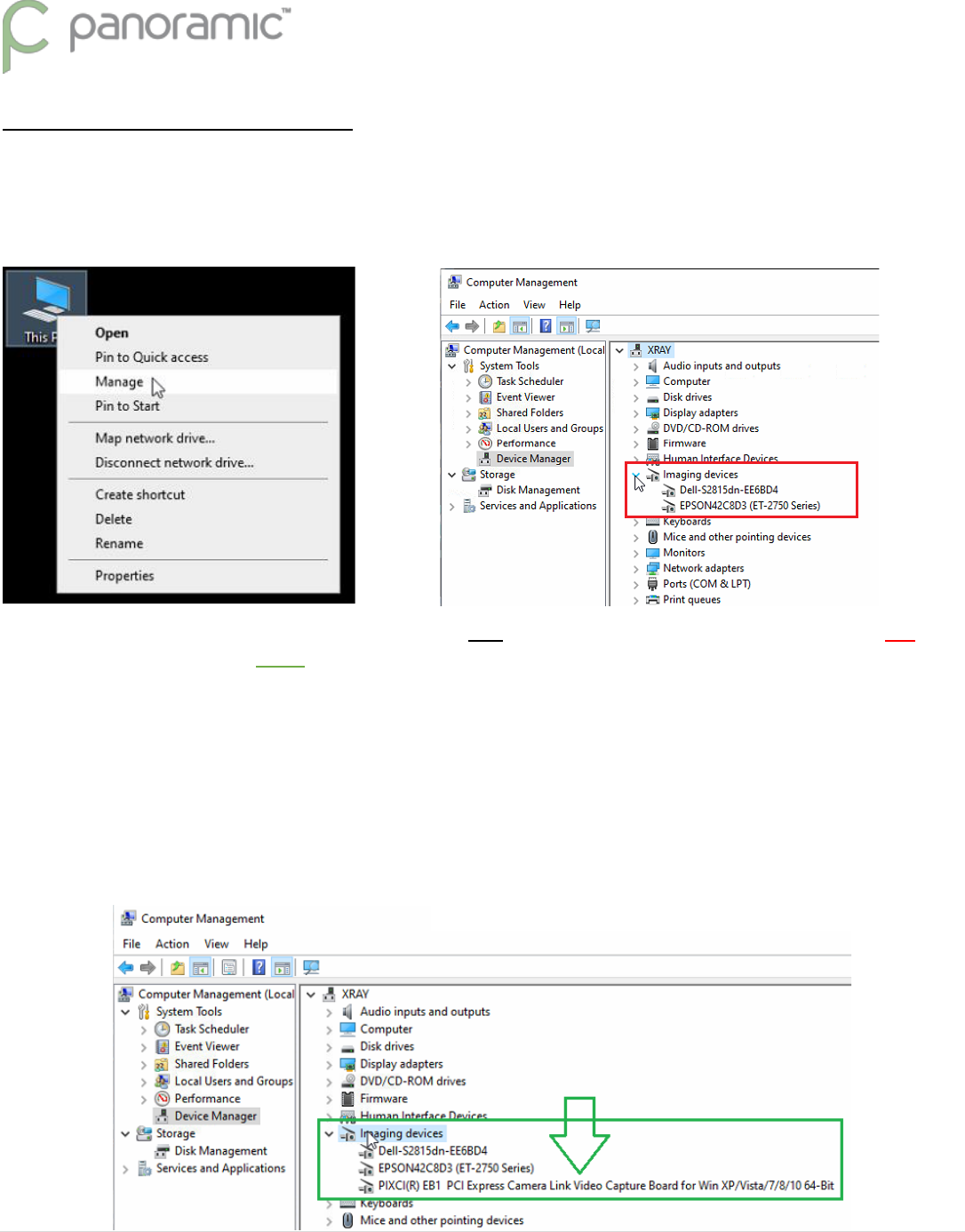
24 | P a g e
Checking the Device Manager
To Check the Device Manager, click on the Device Manager category on the LEFT PANE from the computer management
windows mentioned earlier (Page 21). You can also access this from the start menu search for ‘Device Manager’. Within
Device Manager, look under the Imaging devices category. If ‘Imaging devices’ is not listed, then the card is not
recognized as it’s the only device within that category.
If the EPIX card (PIXCI(R) EB1 PCI Express Camera Link…) is NOT listed in the device manager (pictured above in Red),
compared to correctly below in Green), then the PC does not recognize it, an obvious explanation why the software
can’t interface with it. Restart the computer and check the device manager again to verify if the card is recognized in
the hardware list. If still not recognized, then shut the computer off, and then turn back on (not a restart). If the card is
recognized on a shutdown/turn on, then we refer to this as a HARDBOOT EPIX. Epix card’s with an older Firmware or
compatibility issues with computers/motherboards tend to only work on Clean startups. Be aware of this as the
computer may restart from Windows Updates or other software Restarts.
If the card is continued to be unrecognized or if a connection issue persists, then it is possible the card needs to be re-
inserted into the computer, or use a different PCI-express expansion slot (x16 preferred and/or closest to the center of
the board/CPU)
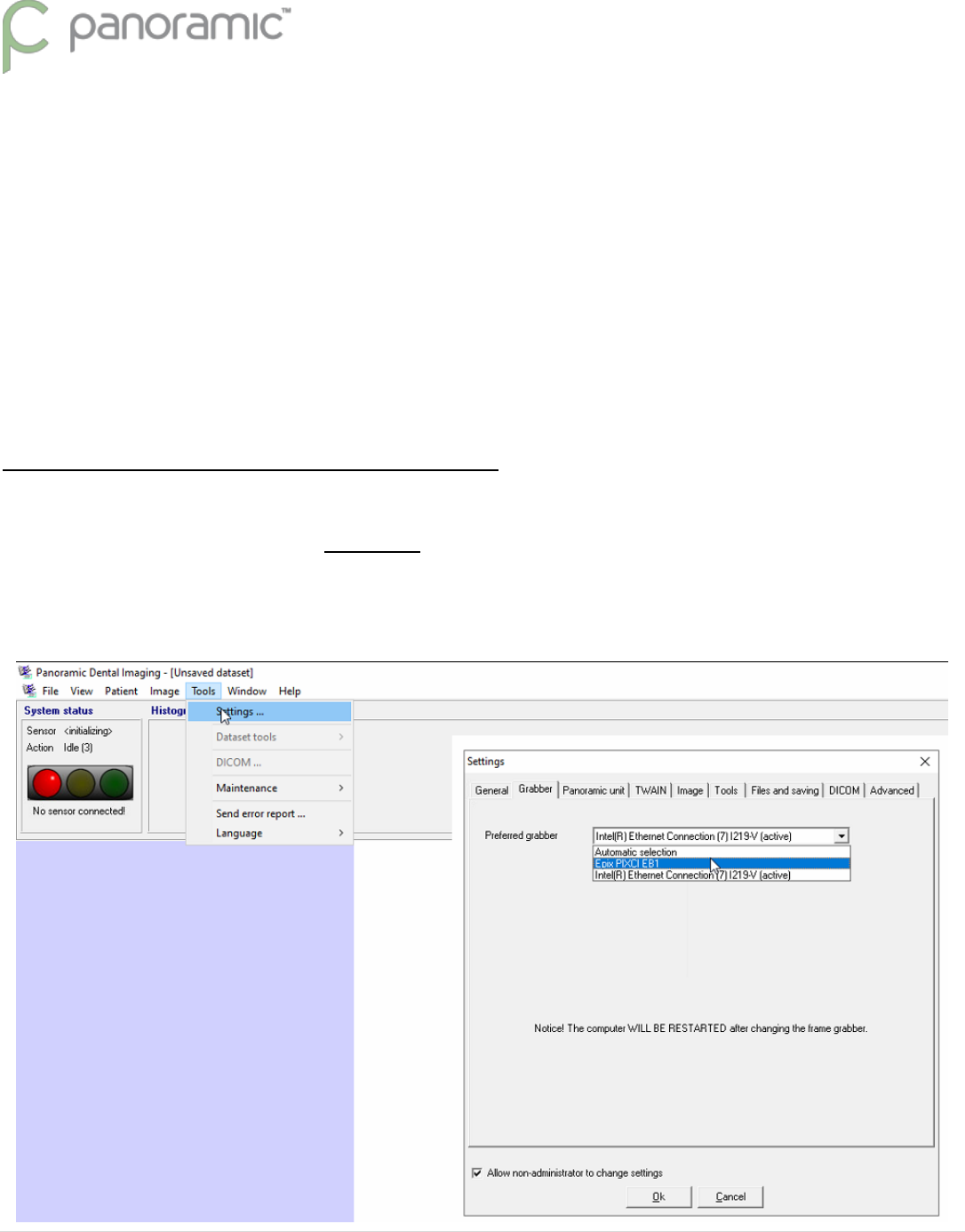
25 | P a g e
SOLVED? Read the possible reasoning below; otherwise continue to the next steps…
If the EPIX card was always recognized in the device manager, and not listed in the software diagnostics window, and
restarting the computer restored the connection status in the software, this suggests the computer was put to
sleep/hibernate. This is also shared with the FAST STARTUP option being enabled in the power options of the computer
with Windows 10, turn this feature off. (For directions on how to do this refer to page 5). It could also be possible that
the registry patch was not installed with the driver on (Page 9).
If shutting down the computer and turning it back on restores the Epix card in the device manager, and the software
connection, then follow the HARDBOOT Epix concept. Whenever there is a connection issue, Shutdown only the
computer off and turn it back on. The only way to avoid this hurdle is to purchase a new card that has a new(er)
firmware. (Inside the software diagnostics v1.3 is a newer firmware)
Verify the Correct Grabber within Settings
If a different option is listed in Diagnostics, other than Epix, Verify the correct grabber is selected in the settings.
Example: The software will look for any INTEL brand Ethernet connection along with the EPIX card. If the computer
onboard network port is INTEL brand, the software might be set to look at that interface rather than the correct one.
From the Tools menu at the top, choose Settings. Under the Grabber tab, choose the drop down list, and change/verify
it is set to EPIX PIXCI EB1. This change WILL REQUIRE a computer restart.

26 | P a g e
Third-Party Interference?
Next evaluate any Anti-Virus software, also any Real-time scanning options. Check the settings of those programs to
best assure they are not monitoring or conflicting with the Panoramic Dental Imaging software folders Anti-Virus
software does not know that the interface is connected directly to an x-ray machine.
Temporarily Disable the software protection to see if the status of the software changes to GREEN.
Folders and Directories to exclude from Anti-Virus monitoring are:
C:\ProgramData\Ajat\
C:\Program Files (x86)\Panoramic\
Processes to exclude from Anti-Virus monitoring are:
C:\Program Files (x86)\Panoramic\ccservice.exe
C:\Program Files (x86)\Panoramic\prtestapp.exe
C:\Program Files (x86)\Panoramic\srvtester.exe
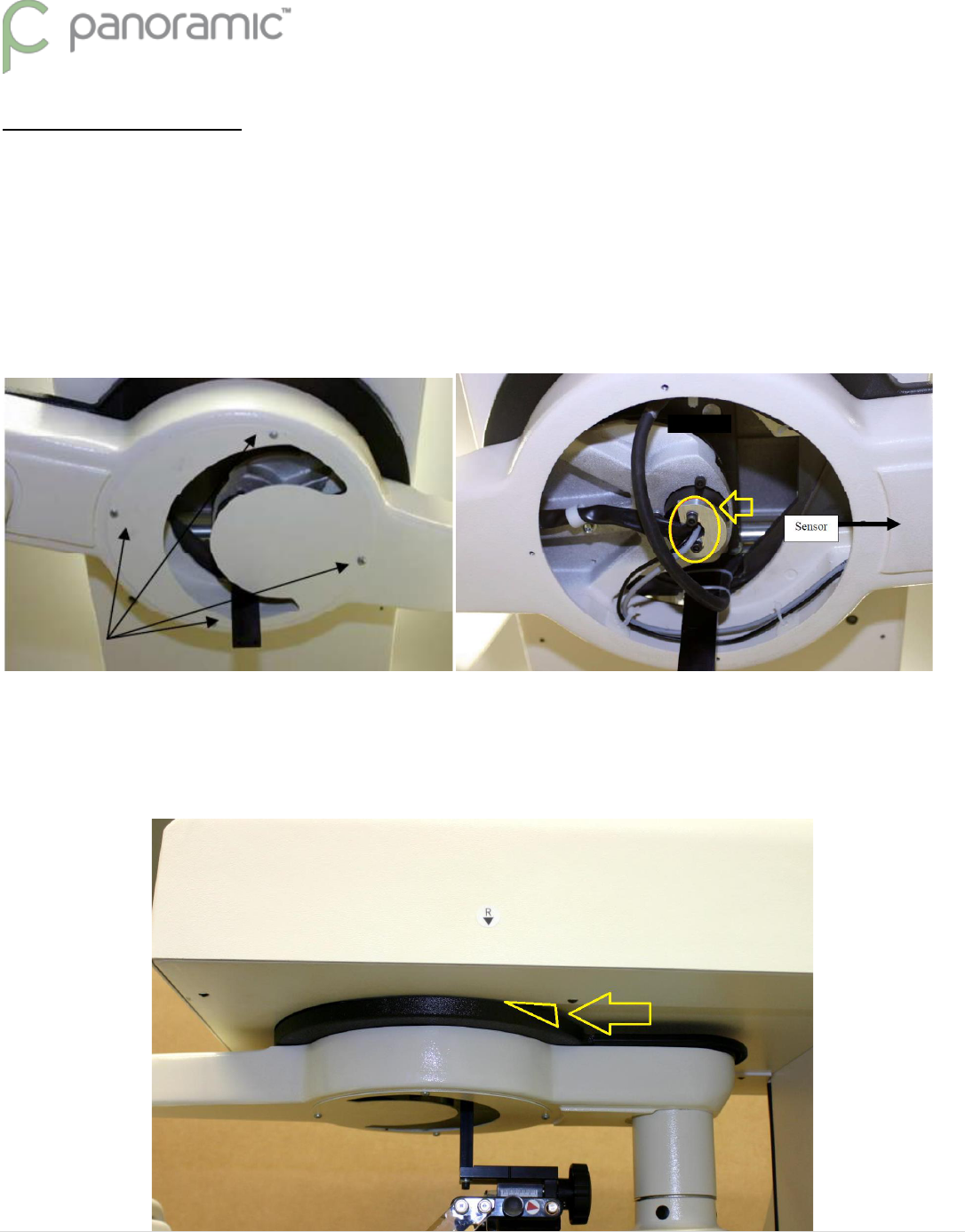
27 | P a g e
Datacable Integrity?
Visually inspect the datacable connection on both sides, the computer connector and sensor. Unplug and plug back in
both ends of the cable. You should feel or hear both sides of the connector snap into place. Also inspect the cable as it
routes through the machine for rips, tears, bends, and kinks.
The best place(s) to look for physical damage would be directly above the patient’s head position, by taking off the
moon-shaped C-arm plate by the 4 phillip screws (or by taking a quick look into the gap to see above). The cable can
tend to rub along the heads of two vertical allen screws. (Circled in Yellow with arrow)
Another area to check would be about 10 inches further up the line. You can best look at this part of the cable by
looking into a gap/hole from the right side. You might need to press the top cover up if slouching, or pull the black trim
cover down if in the way of view.
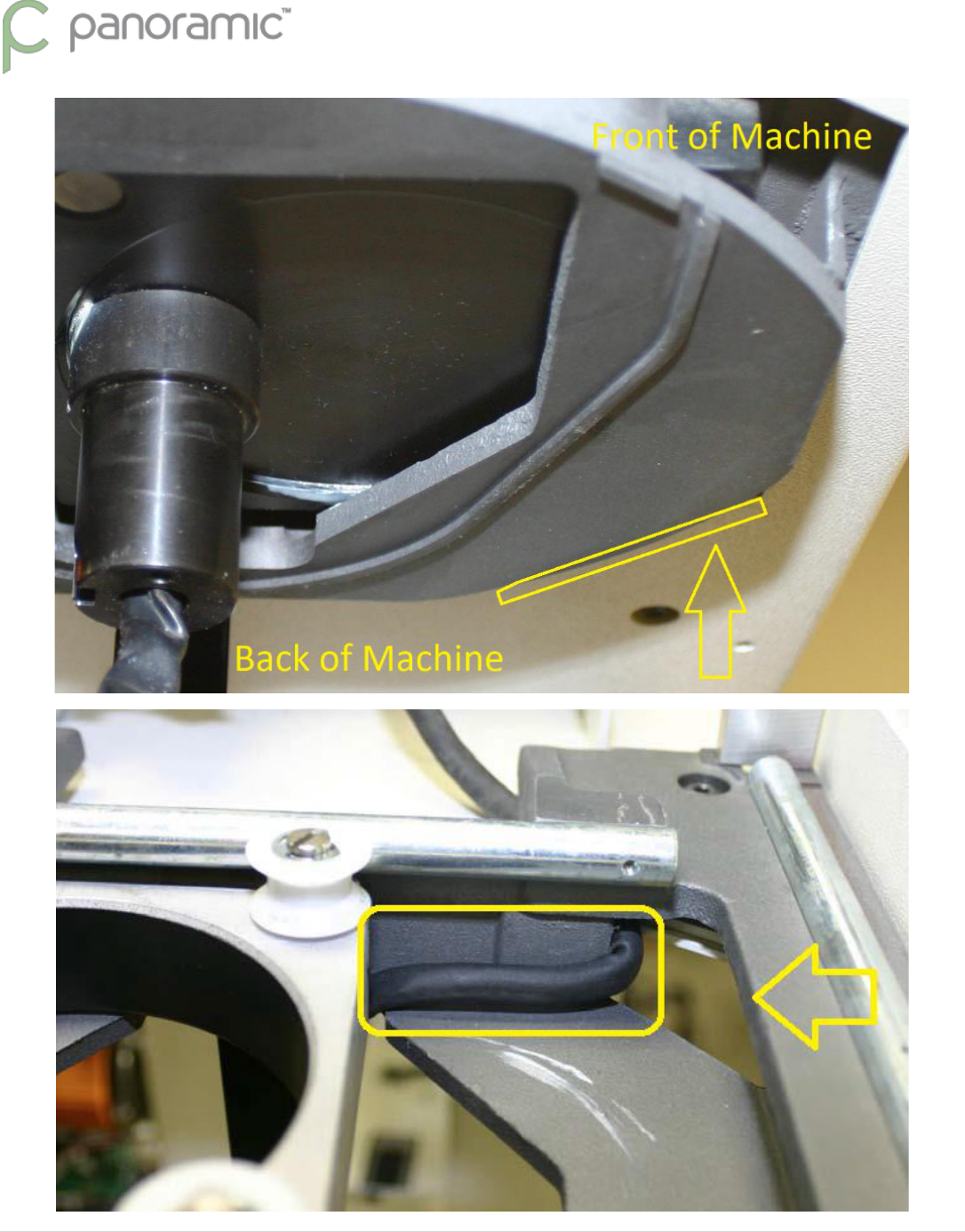
28 | P a g e
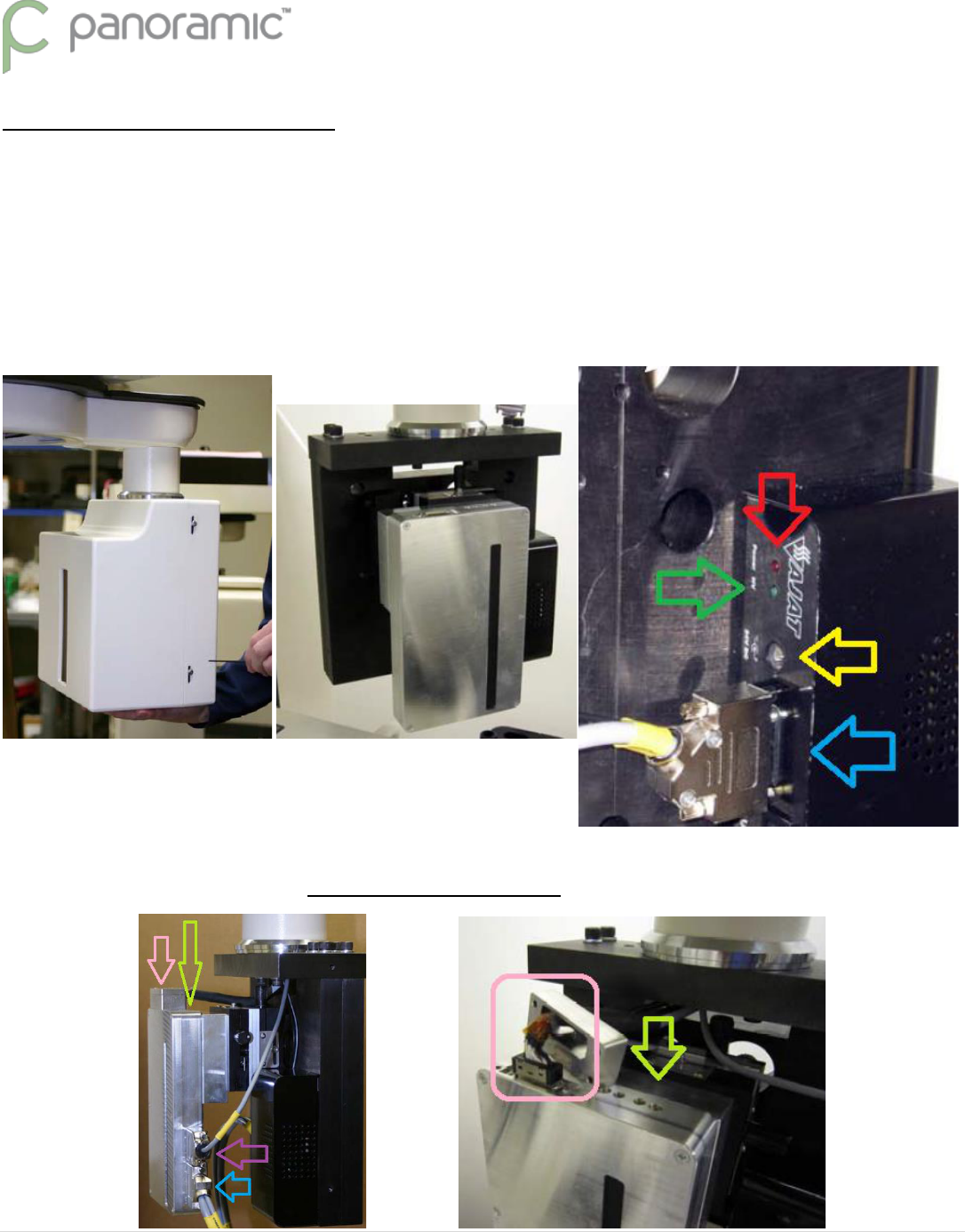
29 | P a g e
Verify the Sensor has Power
Remove the sensor covers by the Four 3/32 allen screws. Locate the Black DS Power supply brick.
The RED LIGHT shows power to the brick. This should be a solid red light.
The GREEN LIGHT shows an active connection to the software. A green light will be in the software as well.
The Yellow arrow is pointing to a 24VDC barrel connector coming from the top of the Panoramic Machine.
(unplugged in the picture)
The Blue arrow points to the power cable connector the brick and the sensor.
The Blue arrow below is the other end to the power cable to the sensor.
The Purple arrow is the ‘trigger’ which tells the software its exposing.
The Pink arrow is where the datacable connector is. (Typically without the metal rectangular cover)
The GREEN arrow below points to the Sensor Power GREEN LED LIGHT. (Independent of the software connection)
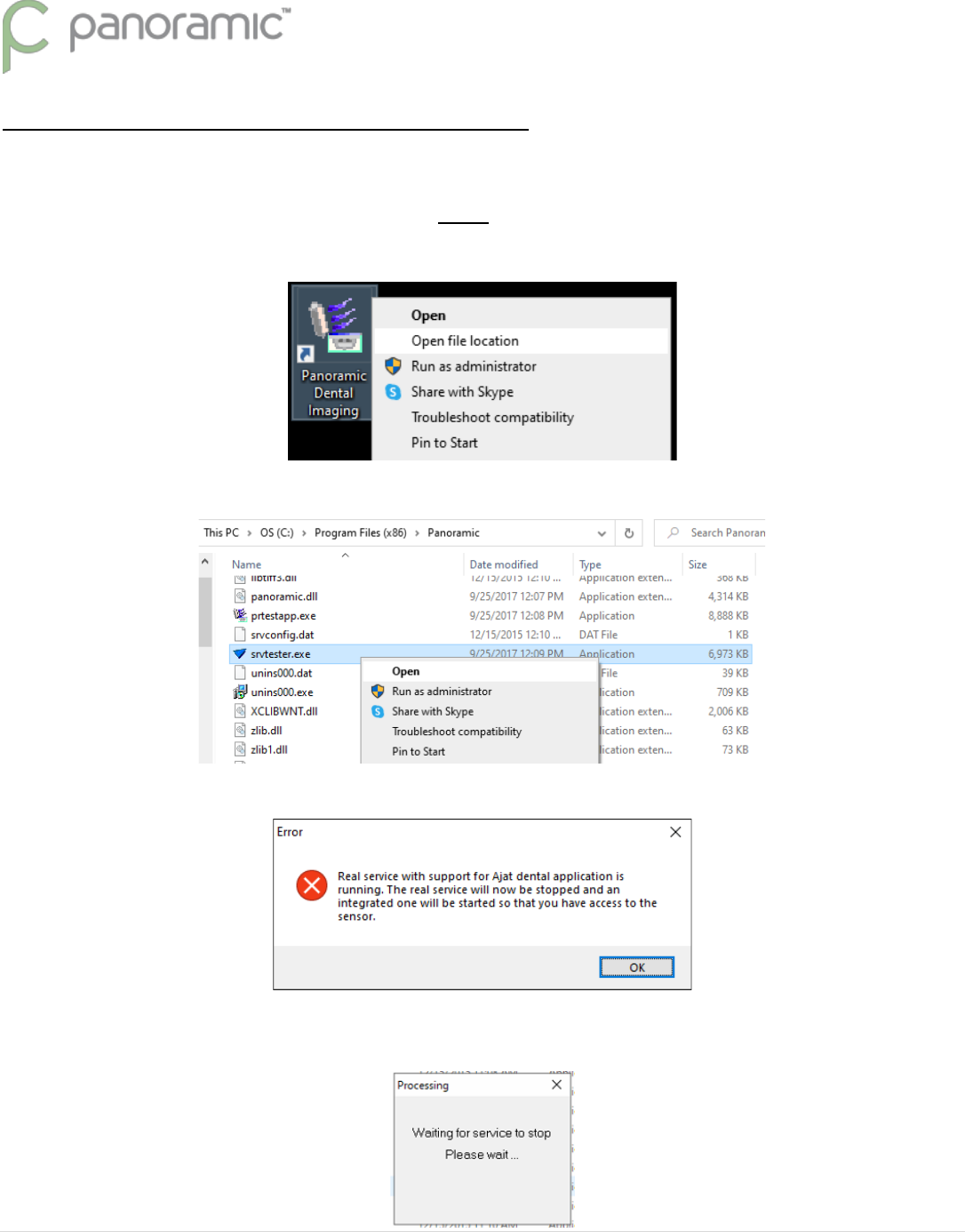
30 | P a g e
(Uncommon) Using the srvtester Application
Using the srvtester.exe application is quite uncommon. Most connection issues that are software-based are resolved
using the instructions above. Of the very few instances where this tool is needed to correct a connection issue, it is
more used on new computer installation/setups. First CLOSE the PANORAMIC DENTAL IMAGING Software if open.
Then Right-click the desktop icon and choose Open file location.
In the Program directory, beneath this file is another called srvtester.exe. Right-click this file and choose Open.
An Error message will appear. This is only a warning/information message. It is not truly an error. Click OK.
Be patient as the software will stop/start some background processes. This takes roughly 5 seconds depending on
computer specifications / performance.
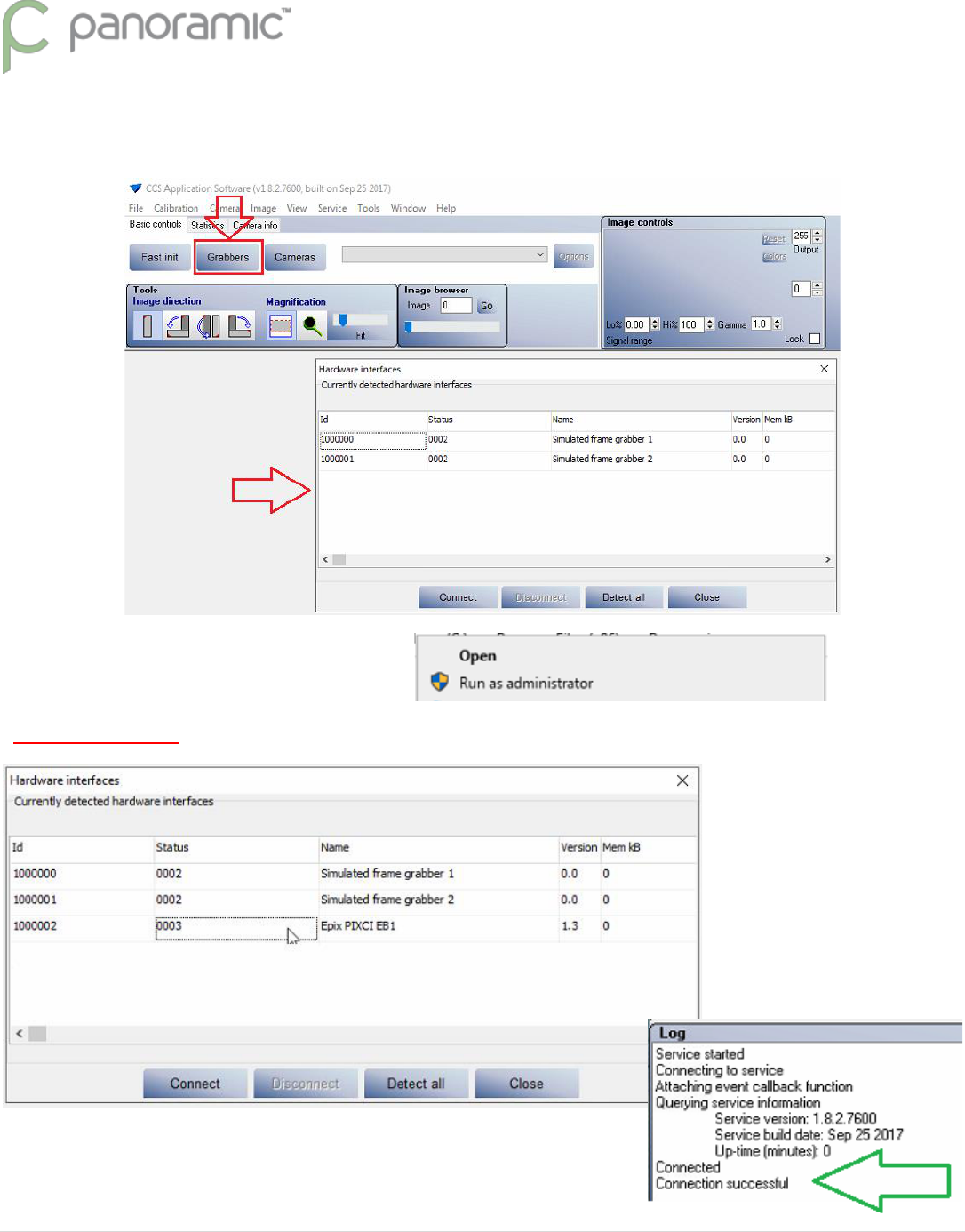
31 | P a g e
Once the application opens, click the Grabbers button in the TOP LEFT.
Choose the EPIX grabber and click Connect.
If the EPIX grabber is not listed, then close the
application and re-run with Administrator Rights.
BE PATIENT!!! The software will want to Start/Stop the background process as you exit & reopen the program.
There is a real-time log of the event in the bottom left of the screen showing
a connection was successful. If there are error codes, it would suggest a
problem with the card, or may need to be physically reinserted into the PC.
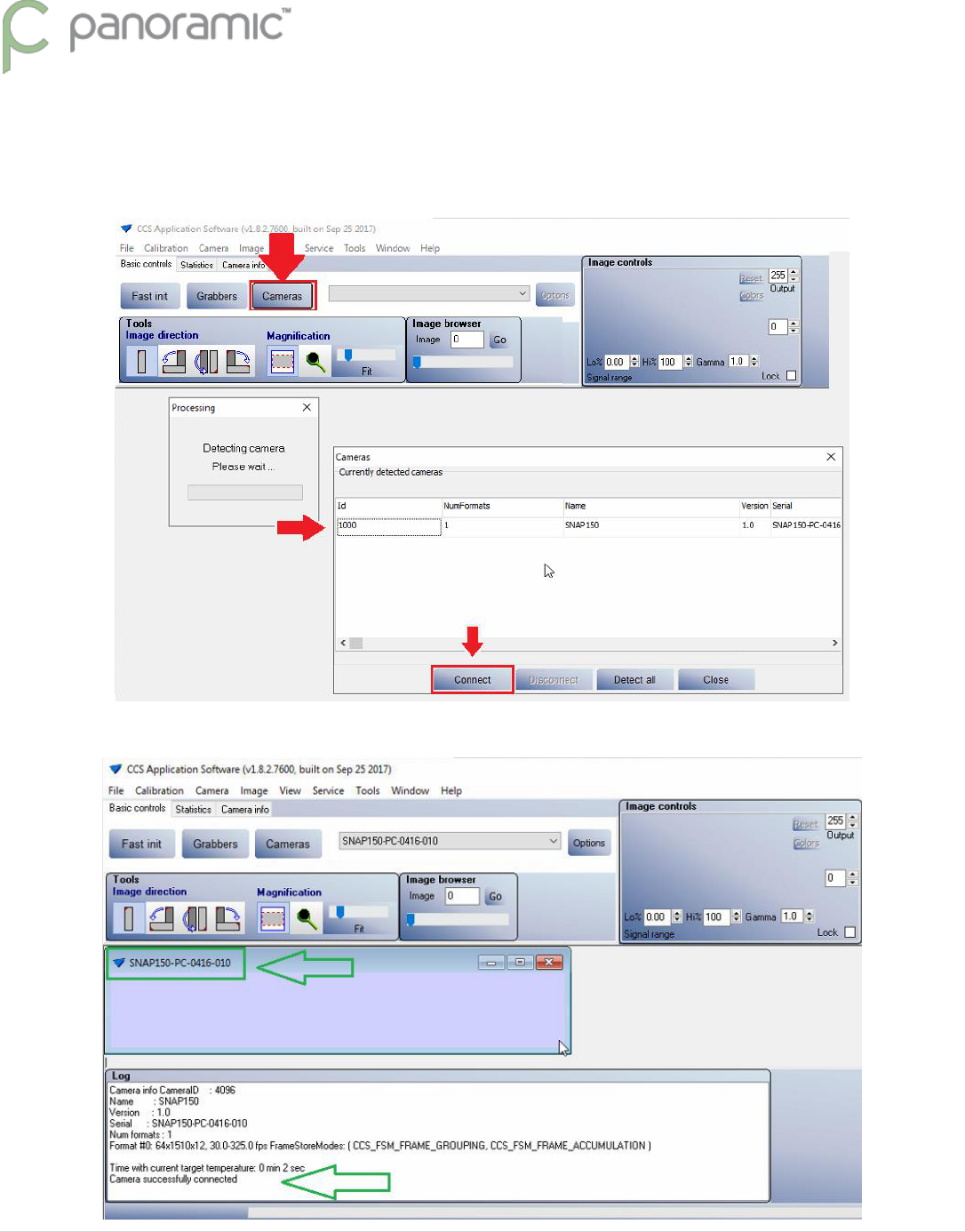
32 | P a g e
Next click the Cameras button in the TOP LEFT.
The software will take a brief moment to Detect the camera, and then display the list.
Click on the sensor shown, and click the Connect button.
Again the real-time log will show a camera successfully connected.
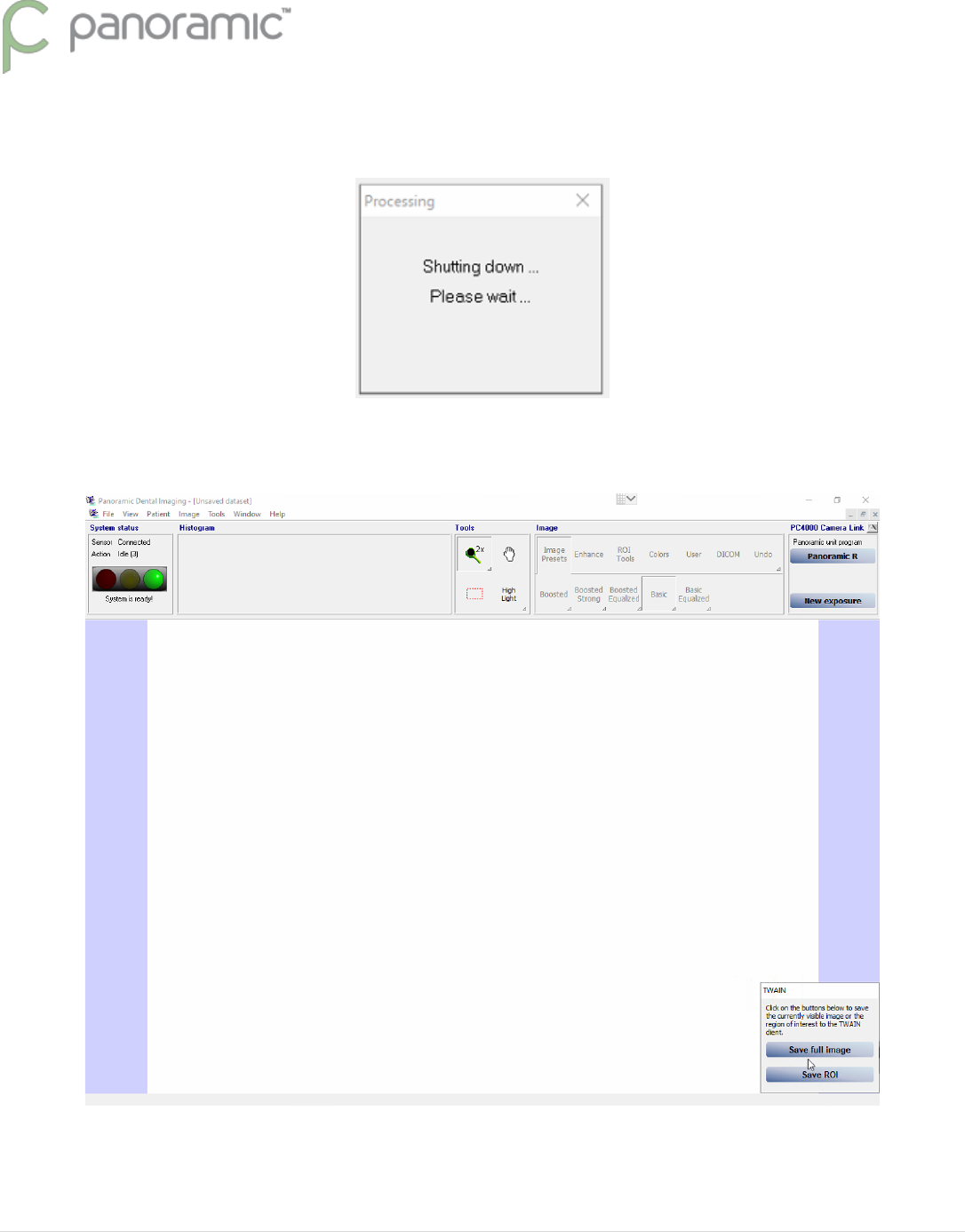
33 | P a g e
After a successful connection, close the srvtester application.
The program will stop/start the background process. Please wait.
After the notice disappears, wait 2 seconds and then Open the Panoramic Dental Software from the desktop shortcut.
You should find a GREEN Connection in the top left.
If the connection was resolved using the srvtester.exe application, this means that the automatic connection feature
within the program could not detect key functions/settings and needed to be told how to connect. This can occur if there
were complications during the software installation steps, or if the grabber was not in the PC at the time the software
was installed. As uncommon as this is, it is typically on a new setup/installation of a computer.
